1lumen selects and reviews products personally. We may earn affiliate commissions through our links, which help support our testing.
Fenix HT18R review
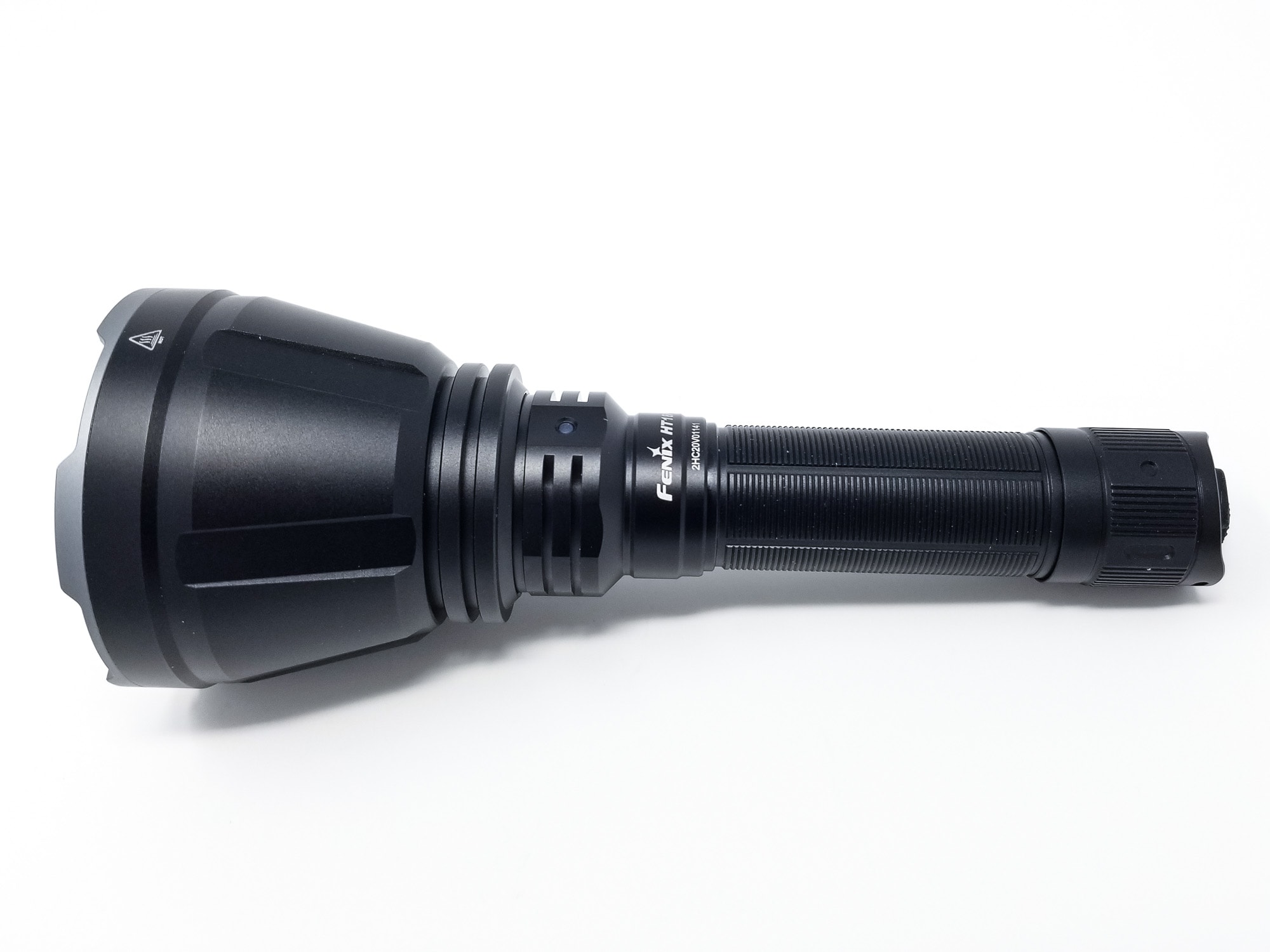
Fenix HT18R specs
| Brand & Model | Fenix HT18R |
|---|---|
| Flashlight category | Thrower/Hunting Light |
| LED | Luminus SFT-70 |
| Max. output | 2,800 lumens |
| Max. beam distance | 1100 meters |
| Max. beam intensity | 300,000 cd |
| Battery config. | 1*21700 |
| Onboard charging | USB C |
| Main modes | 4 |
| Blinkies | Strobe |
| Waterproof | IP68 |
| Review publication date | December 2023 |
Review intro:
I’ve been busy of late with these Fenix lights, and that’s totally fine! Fenix Lighting Company LTD (part of Open Air Brands, LLC), is an innovator in the portable lighting industry with over a decade of experience turning out flashlights and other lighting devices to professionals and ordinary folks alike. Today, I’ll be taking a look at one of their longer-range throwers that’s also turned out to be a pretty versatile general-purpose rig, the HT18R.
The HT series is Fenix’s long-range lights, consisting of larger reflectors and high-intensity LEDs, and also features their lone LEP, the Fenix HT30R. These also do double-duty as hunting lights, with interchangeable filters, or in the case of the HT32, switchable, integrated red and green LEDs. This is going to be the V2 of the HT18, which was released in 2020. The ‘R’ version adds a new LED, updated tailcap and switchgear, and a significant beam distance and output boost. Let’s take a look.
Package quality.
The HT18R comes in Fenix’s upmarket packaging consisting of a large, lift-off lid study box with the requisite graphics and feature blurbs and specs. Inside, the HT18R is sitting in cut-to-fit microcell foam for protection. The accessories are riding in the box:
- Fenix HT18R
- Fenix ARB-L21-5000 V2 5000 mAh 21700 battery
- Lanyard
- Holster
- Charging cable
- User manual
- Marketing materials
- Warranty Card
- Red and green filters
This is a complete package with all you need to get going. Unscrew the tailcap, remove the isolator, and you’re good. I like that Fenix included the holster since that’s going to be the preferred carry method. The included battery is Fenix’s non-proprietary V2 5000 mAh variety, and it’s a good quality cell. It was sitting at 3.6 volts for storage.
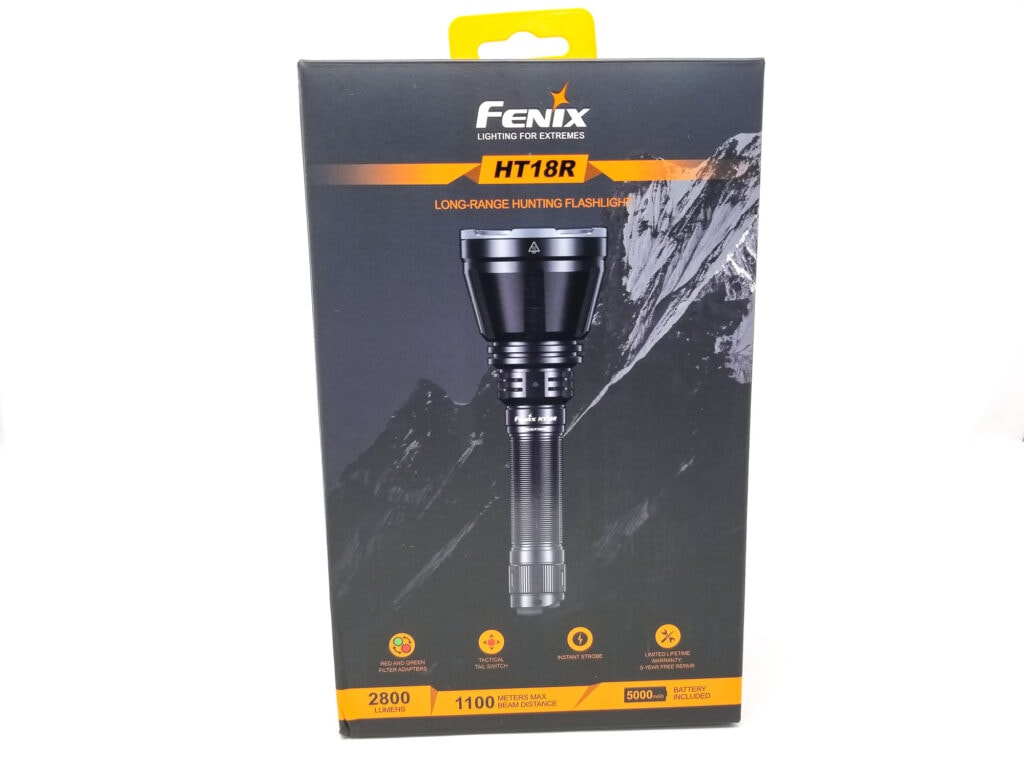
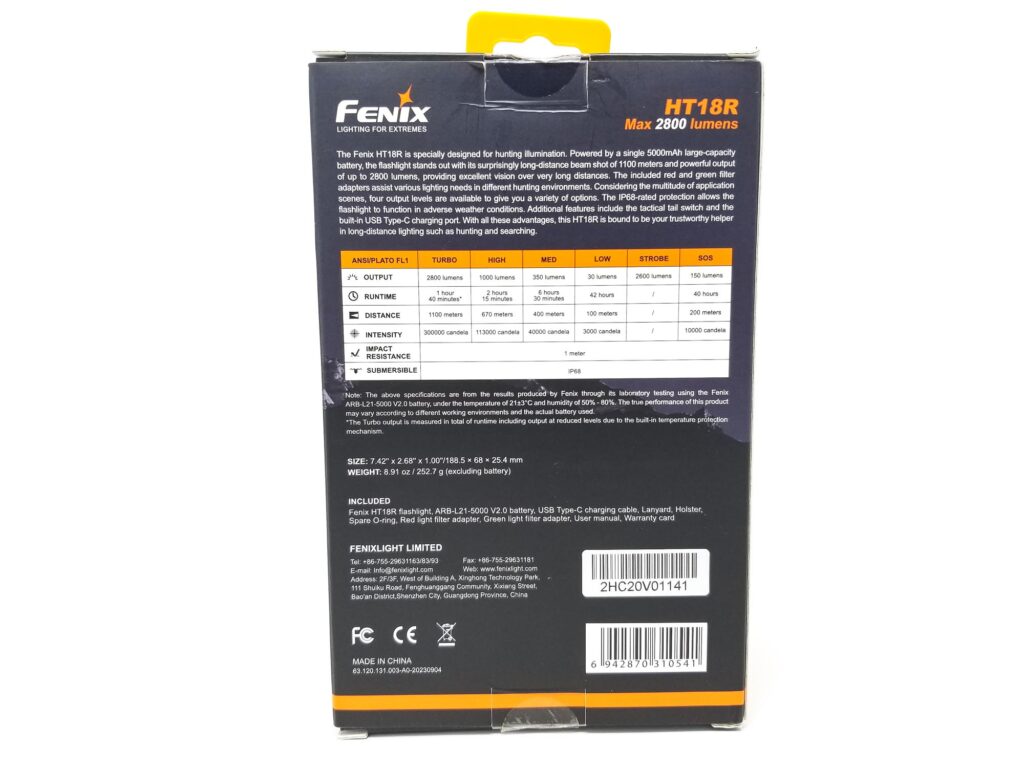
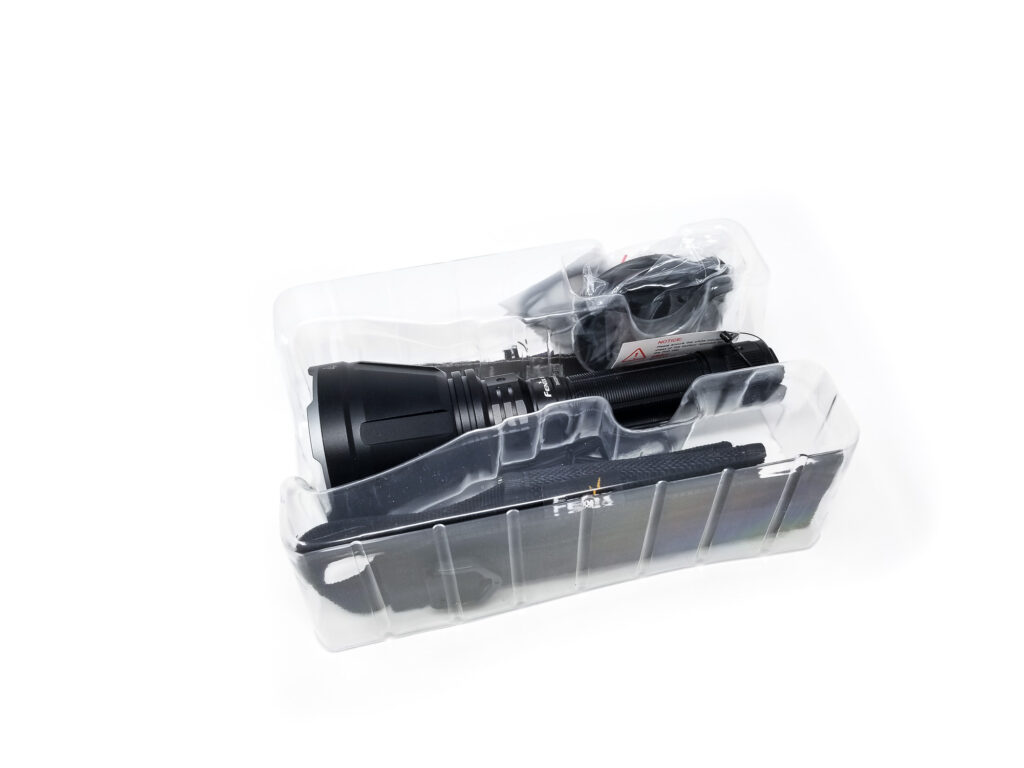
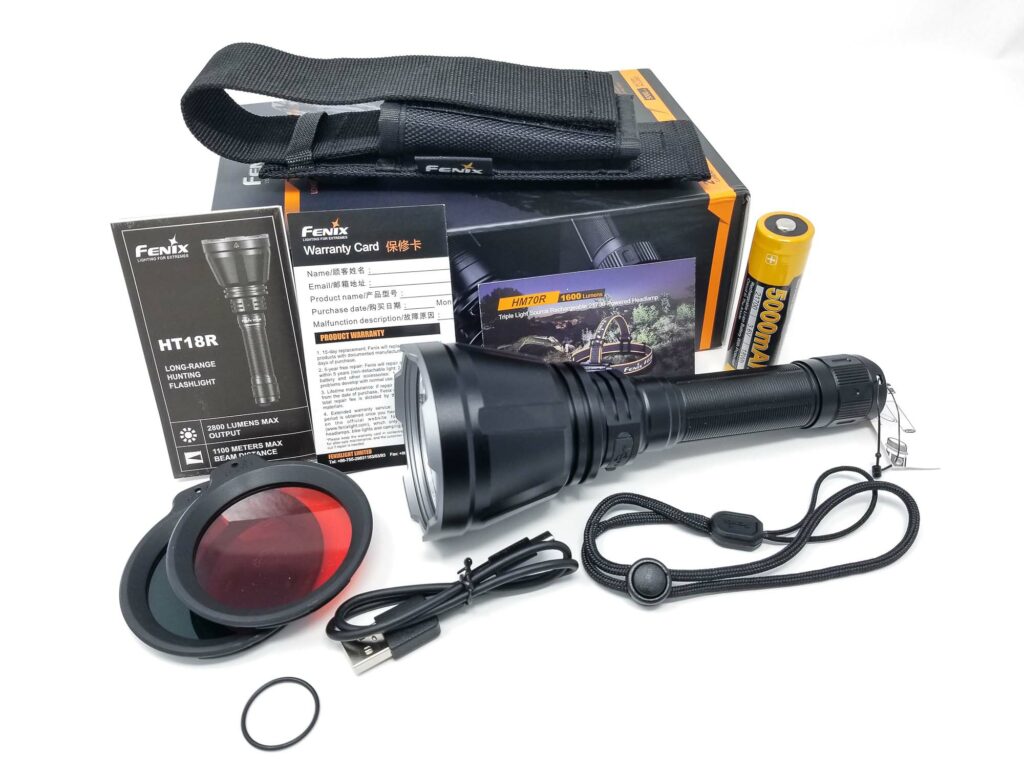
Flashlight in use, Build Quality, and Warranty
The HT18R is a long-throw (+1000 meters) multipurpose flashlight, but the target audience is hunters, owing for the red and green color filters included with the flashlight. I’m not sure why red or green filters are useful for that application, but maybe it has something to do with detecting blood trails or minimizing harsh wavelengths of light that startle game?
Spotlight hunting is also regulated in some jurisdictions, so be sure to check local laws before shining lights in critter’s eyes. Handling-wise, the HT18R is just like the Convoy L21B and Speras T3R I reviewed, with a single-cell body and roughly 65+ mm head. The tube has Fenix-centric reeding and grooves, which make a good gripping surface, and the light points pretty naturally with good balance. There’s no side switch here to manipulate and this helps with a rear-biased grip position.
As mentioned, I like that Fenix included a holster with the HT18R for belt carry, or you can clip it to your web gear or other attachment point. There’s two lanyard mounting points on the tailcap as well, and the included lanyard threads through (albeit with some persuasion). Since this is a hunting-oriented light, it’s compatible with Fenix’s weapon mounts:
- ALG-00 and ALG-15 M1913 Picatinny rail mount
- ALG-16 M-LOK mount
- ALG-18 barrel mount
- AER-04 and ALG-05 remote switches
- ALB-10 bike handlebar mount
The included red and green filters fit inside the bezel and are held in by their rubber frame creating an interference fit. They require some force to mount and won’t come out under normal use. I think they do a good job changing the white light to red/green, even if they’re not as good as a true red or green LED.
The switch arrangement has been revised from the first HT18. That light had a rear forward clicky and a side e-switch, but the R switchgear is identical to the TK20R V2 and TK16 V2. Consisting of a mechanical forward clicky switch and a smaller momentary e-switch above it. The clicky switch has a large, grippy boot and is for on/off or momentary use, and the smaller, oval-shaped e-switch is for instant Strobe and mode changes.
The mechanical switch has a great feel, with solid, snappy clicks and great feedback. It also sticks out quite a bit, which makes manipulation easy when wearing gloves. The e-switch sticks out enough to be tactile with gloves on as well, although the clicks and feedback aren’t as positive. Both switches are weighted very nicely with the right amount of resistance to clicks to avoid accidental activation. I had no trouble manipulating both switches with my thumb in the overhand grip. I liked it on the TK’s and I like it on the HT18R. The switches make tail stands impossible though.
Every Fenix light I’ve reviewed has been top-notch in build quality, fit, and finish. You’re paying for a high-quality, professional-grade tool, and prices reflect that. The HT18R comes in around $140-$160 US, and this is competitive with other similar lights. The Convoy L21B is the outlier though at about $100 cheaper, but you’re giving up features like onboard charging, less output, dual-switches, filters, lab-tested performance, premium battery, and some other creature comforts. Bottom-line: If you need the HT18R’s features, performance, and reliability, get it.
The HT18R is milled from high-grade aluminum alloy. Machining, fit, and finish are exquisitely tidy with no misaligned parts, gaps, or blemishes. The edges are all chamfered and smoothed, and the silkscreen text and laser-etched graphics are crisp and sharp with nice contrast against the finish. The finish is type III HA hard anodizing, and it’s the typical Fenix semi-gloss black. It’s not my favorite for grippiness or feel, but gets the job done and is going to be very durable. I’ve banged around some of my Fenix lights and the finish has held up very well! I’d bet it’s close to the true MIL-A-8625 which is 2-2.5 mils.
The light is glued together, so only the tailcap is removable. The driver-side and tailcap both have gold-plated coil springs, each properly thick for a low-resistance current path. Springs on tactical or pro-use lights are very important because they improve durability and add protection from recoil impulses and shock loads. That’s important here since the HT18R can be mounted to a long gun. There’s no signal tube, which adds additional durability. The rear threads are fully anodized rectangular cut units. They’re oh-so-buttery smooth with plenty of lube. With a glued-up body and single o-ring at the tail, Fenix gives the HT18R a very appropriate (and necessary) IP68 rating for water resistance and a 2-meter drop protection rating.
Fenix’s warranty is one of the best out there with support in the US and abroad: Fenix Lighting US, guarantees all Fenix products purchased from retailers to be made of first-class materials and therefore provides a lifetime warranty against any defects in material and workmanship. Excluded from warranty coverage is any damage to the exterior deemed reasonable wear and tear such as scratches and/or fading of color. In addition, the warranty does not apply to damage caused by abnormal or unreasonable use of any of the components. This includes use of unapproved batteries in Fenix products.
This warranty is in place of all other warranties, including warranty of fitness for a particular purpose and warranty of merchantability, and excludes any liability for incidental or consequential damages. If your Fenix product has a manufacturer’s defect covered by our warranty, we will either repair or replace it, at our option, without charge. Most damaged Fenix products not covered by the warranty can still be repaired. If repair costs and handling charges apply, you will be notified prior to any service. All warranty repairs or replacements are at the sole discretion of the Fenix Lighting US Authorized Repair Center, and we reserve the right to refuse a request.
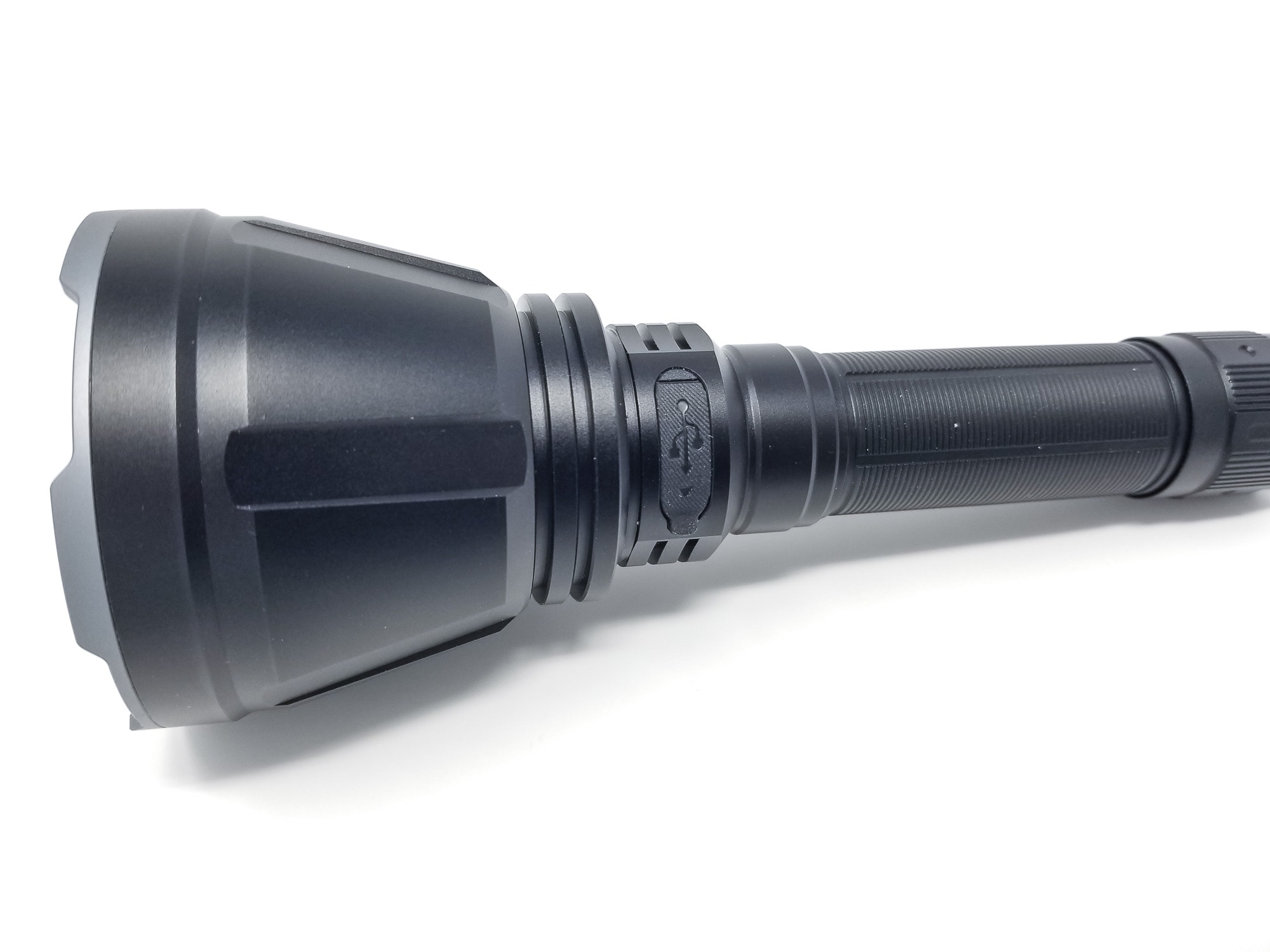
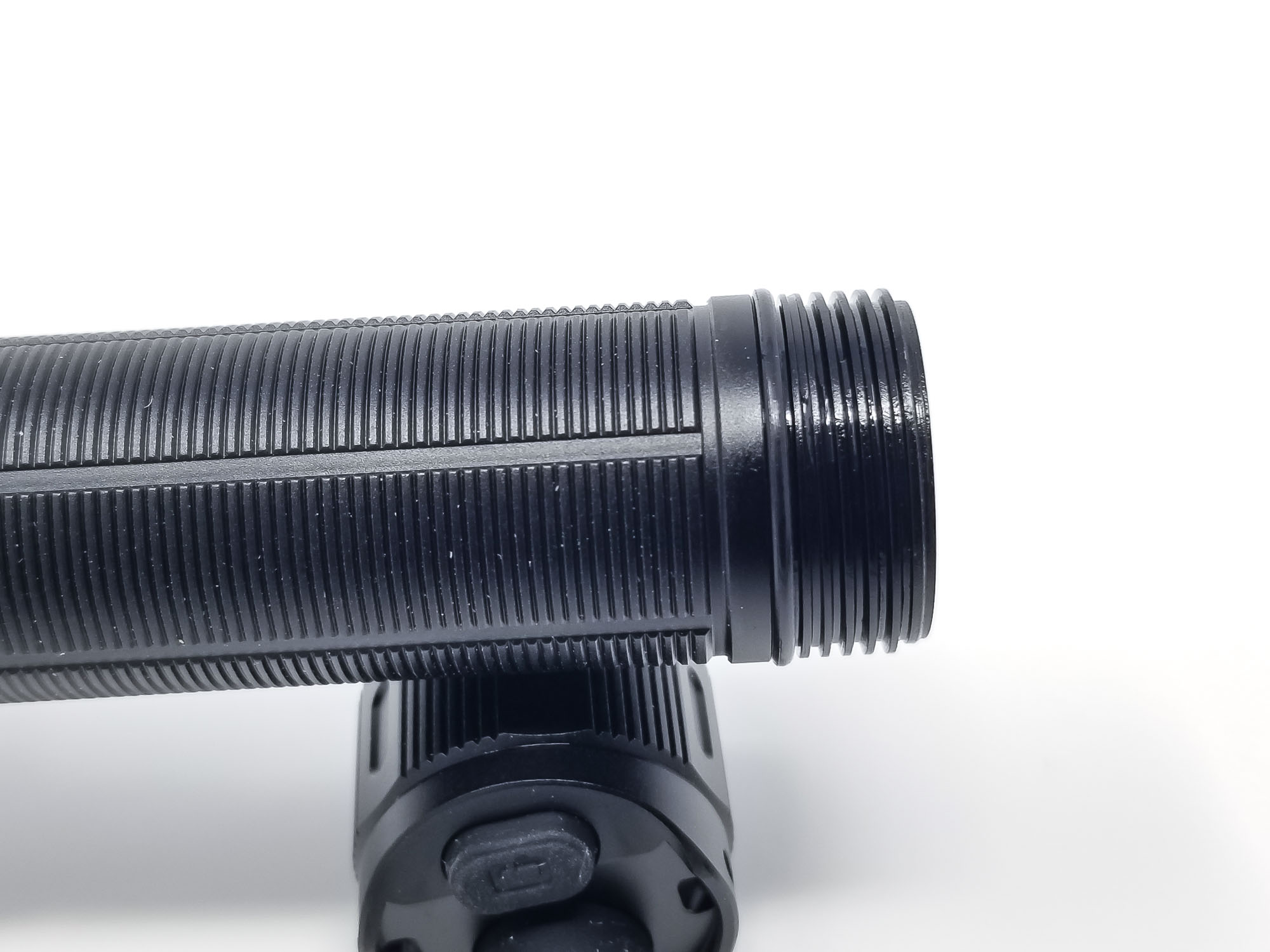
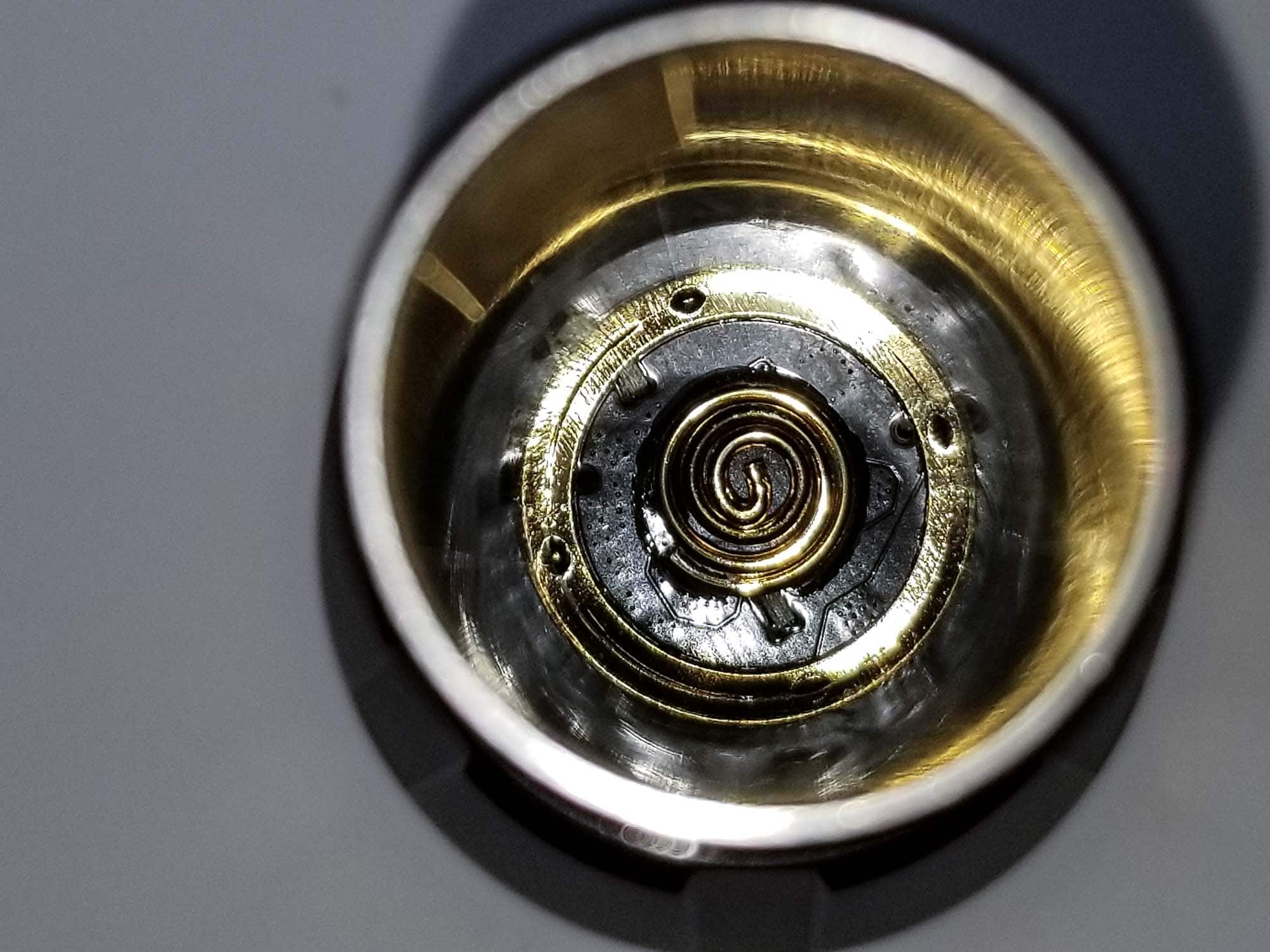
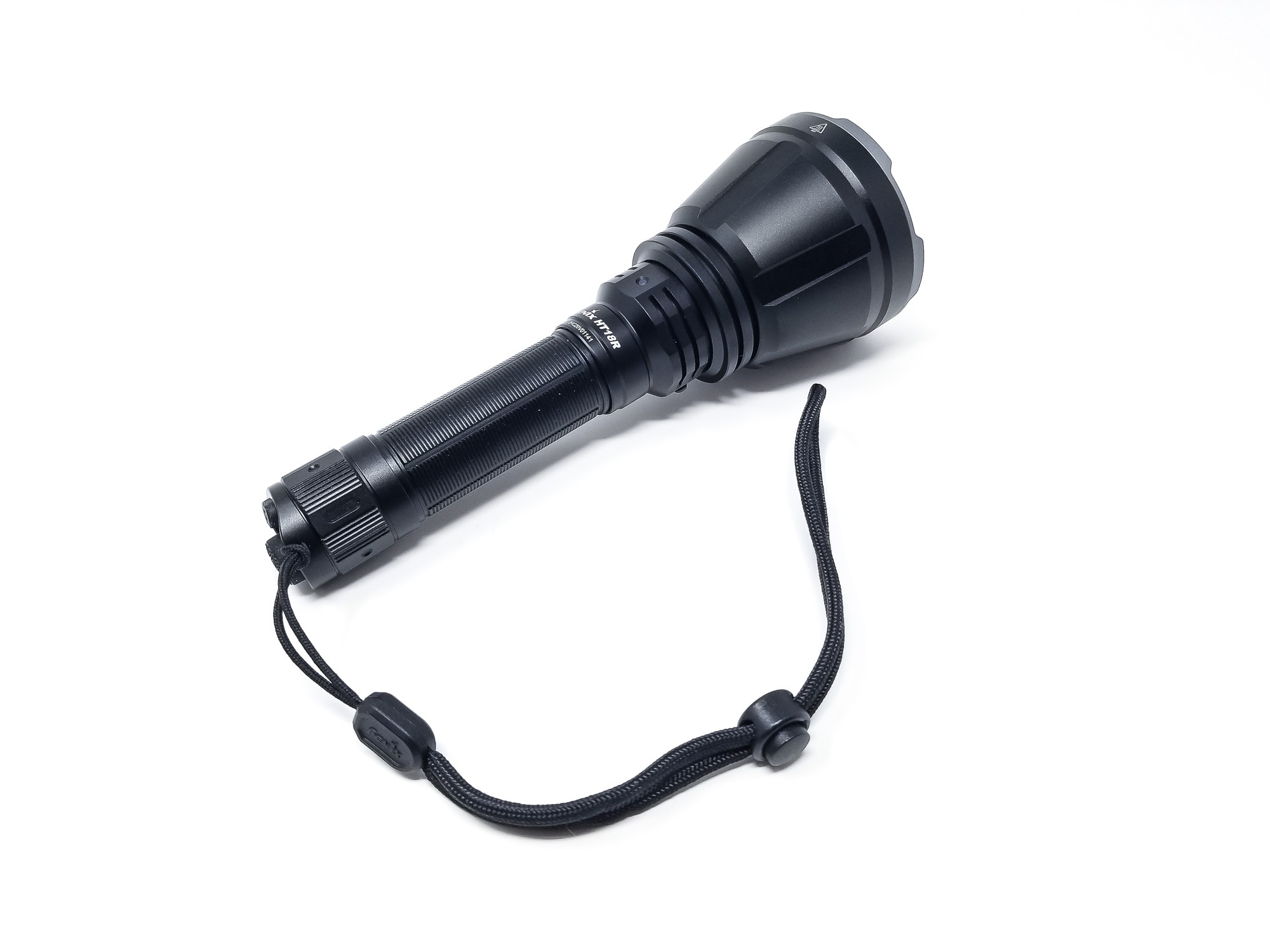
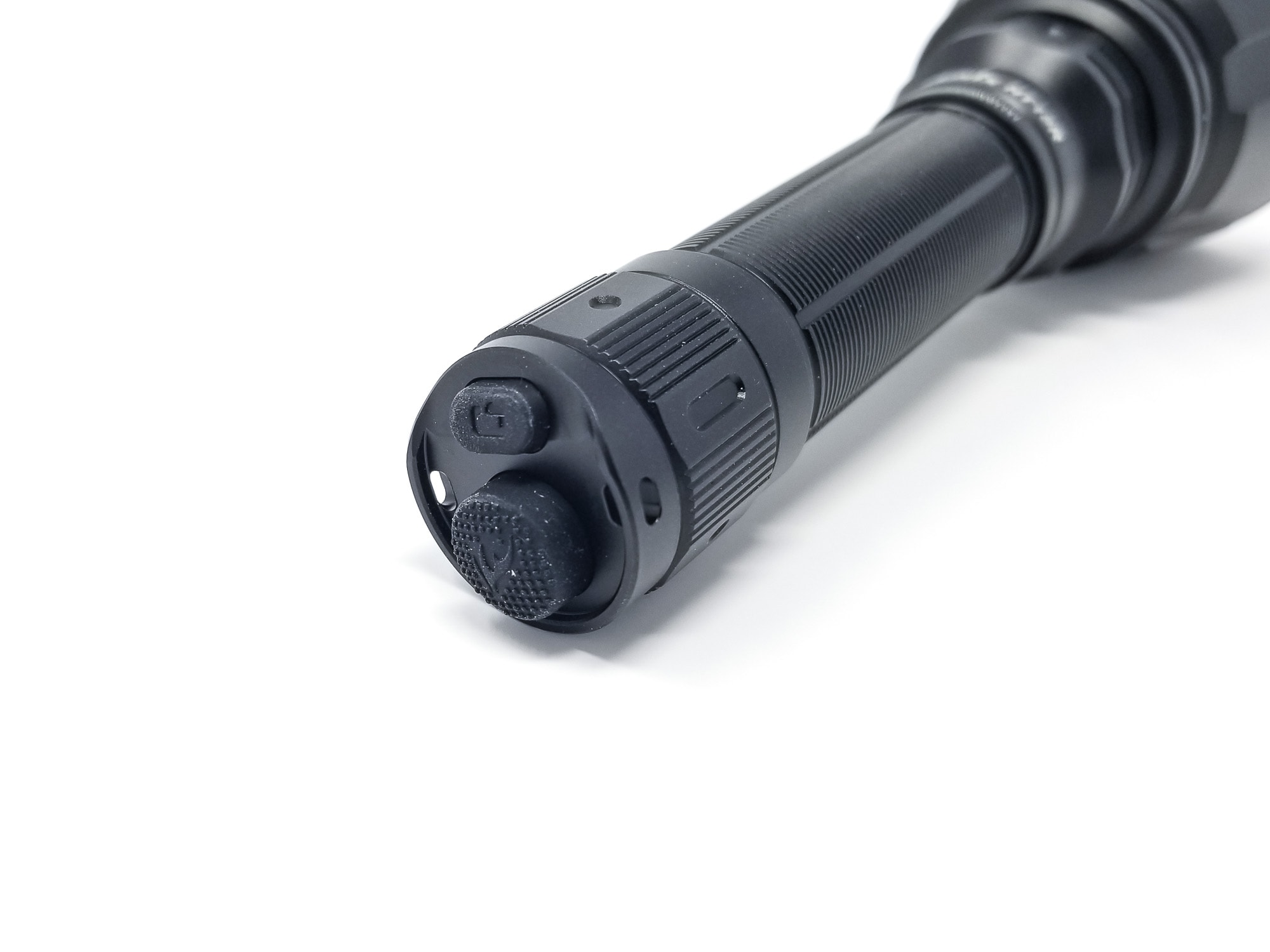
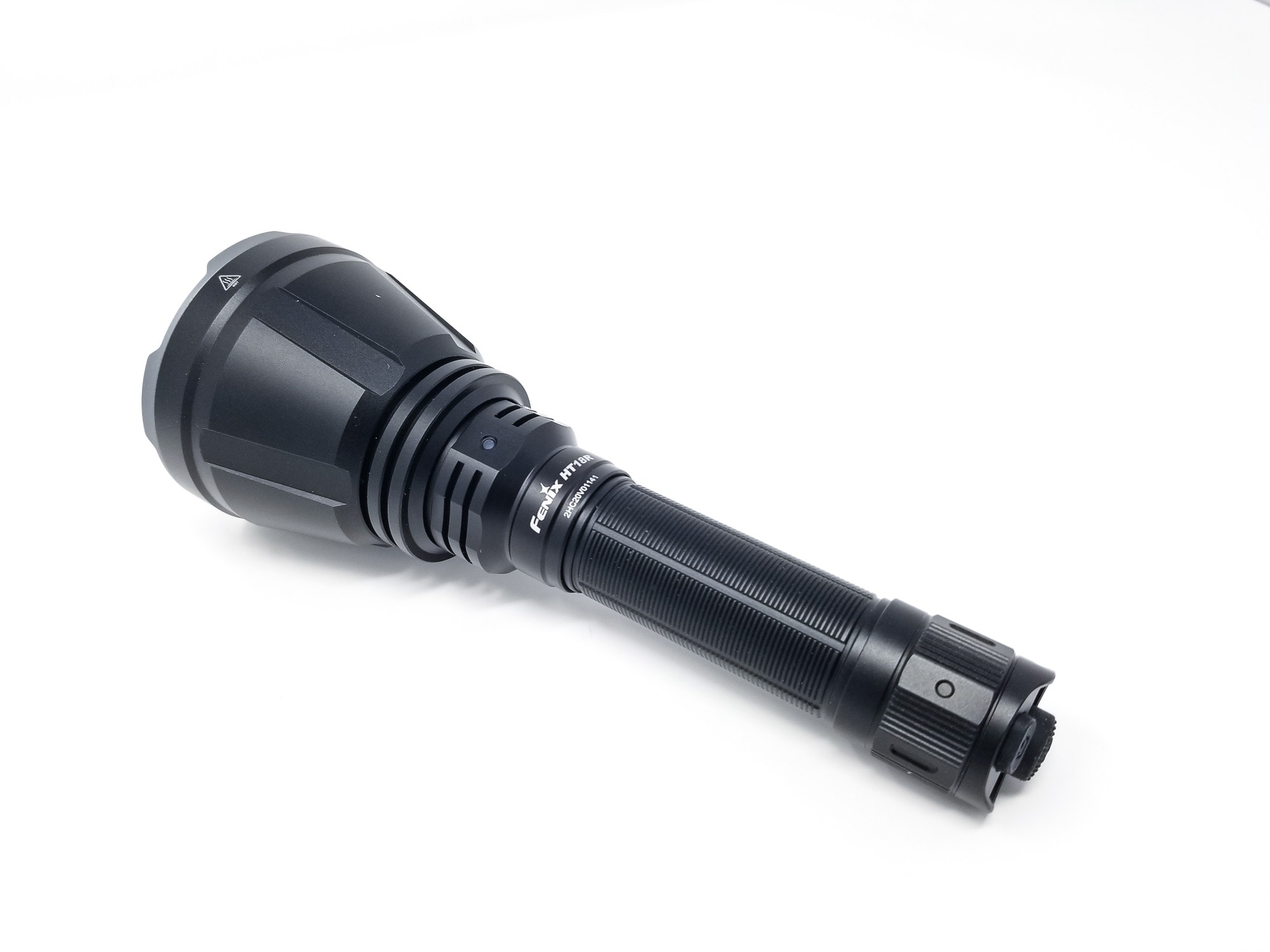
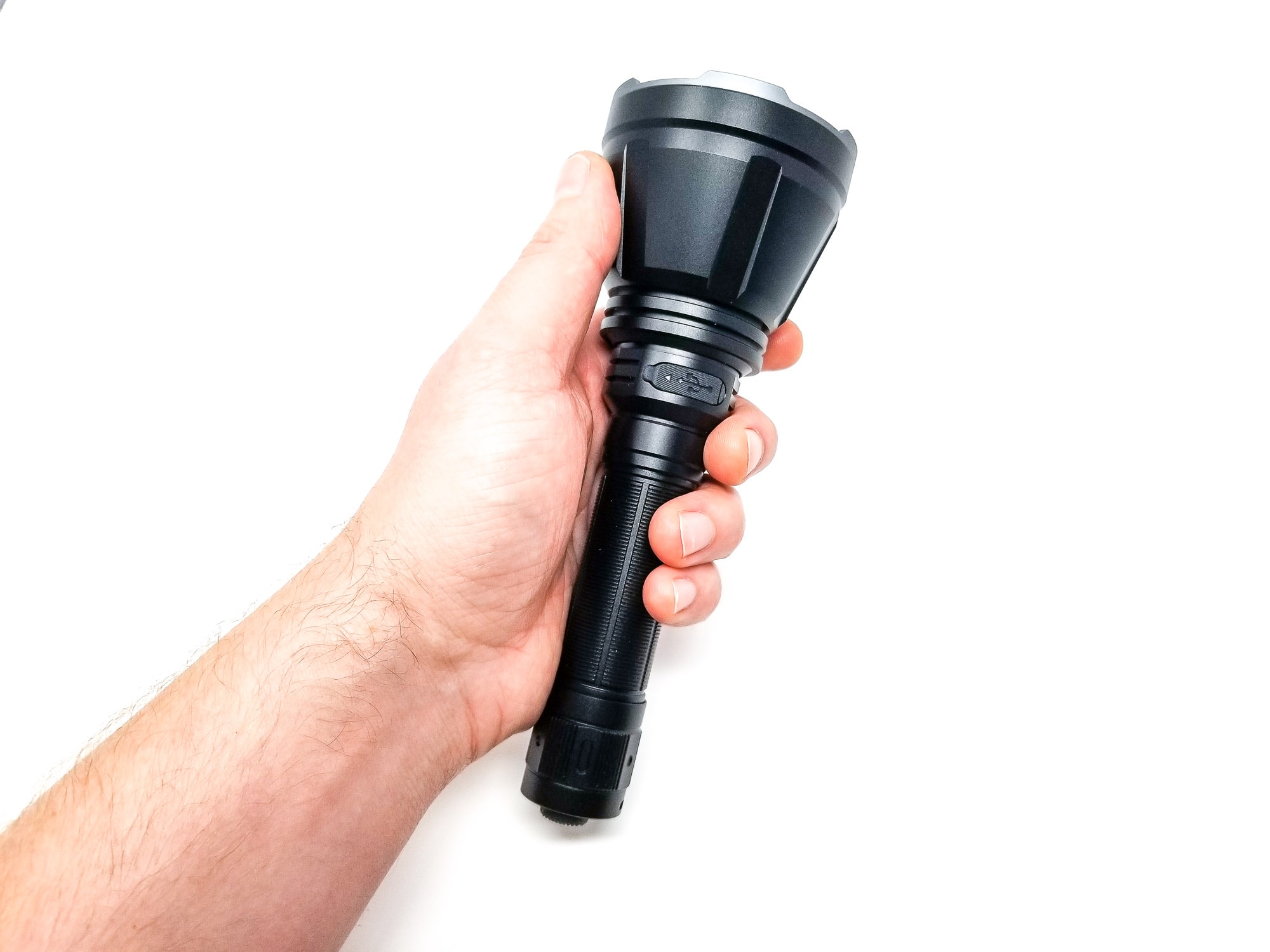
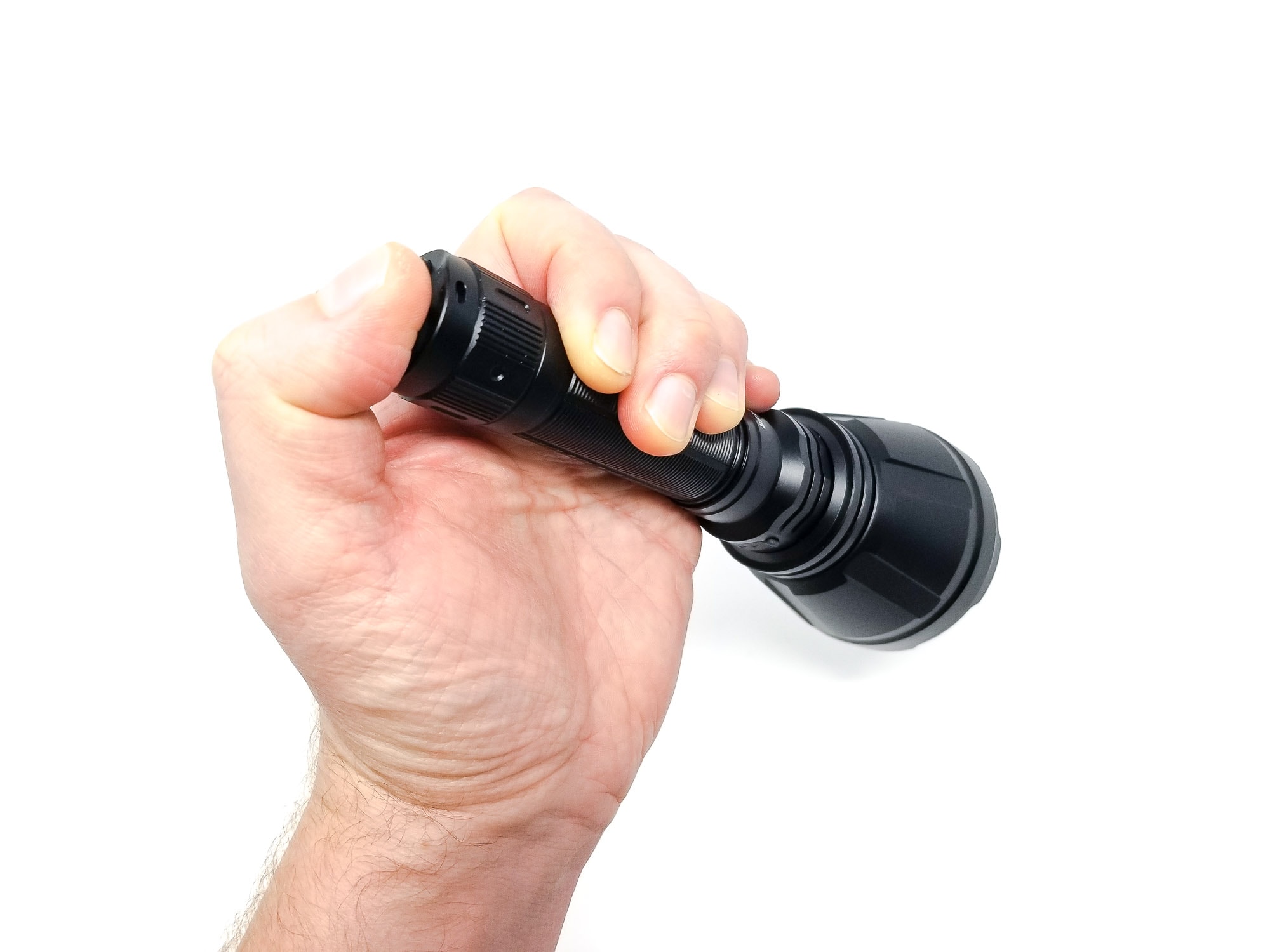
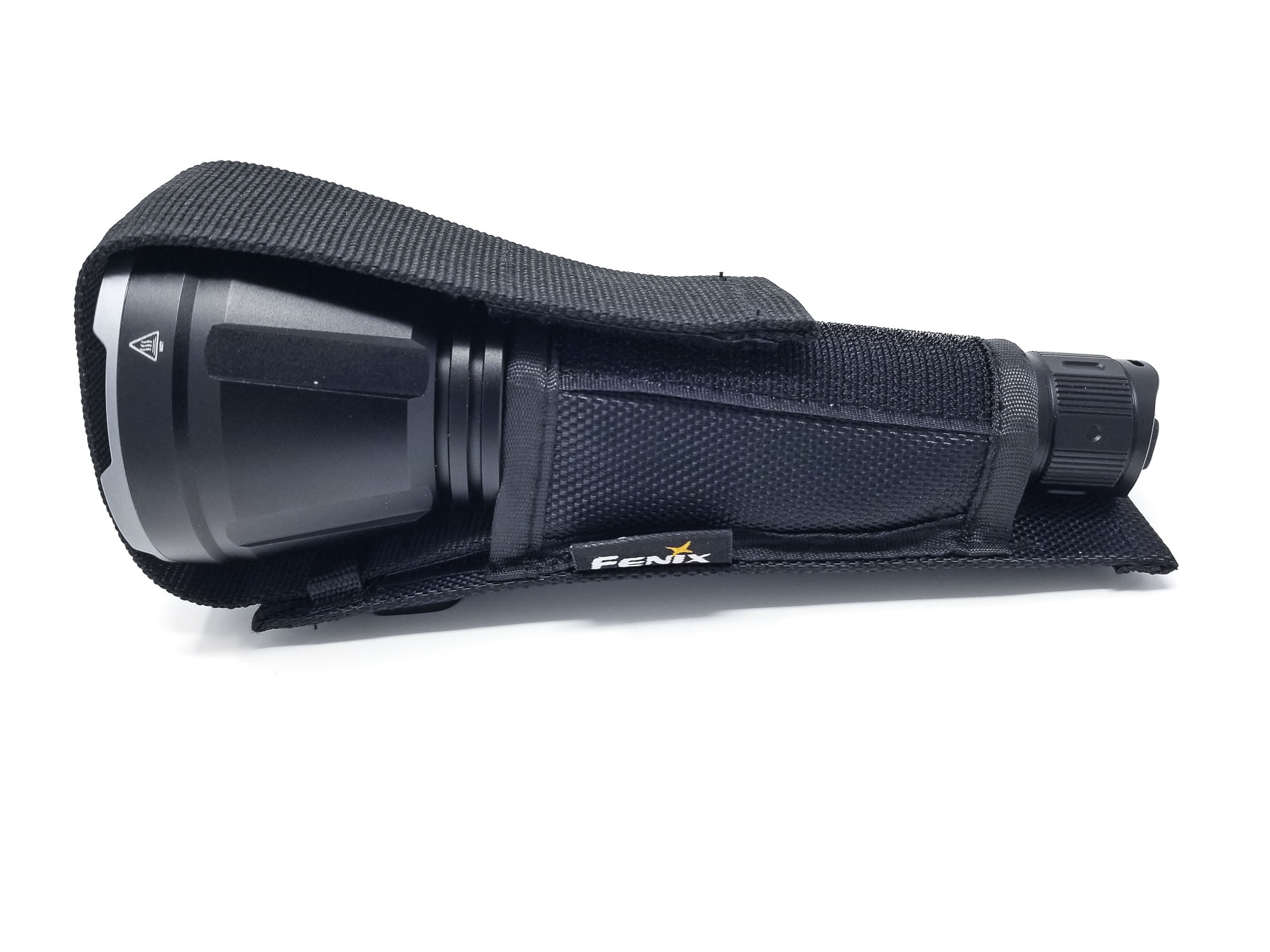
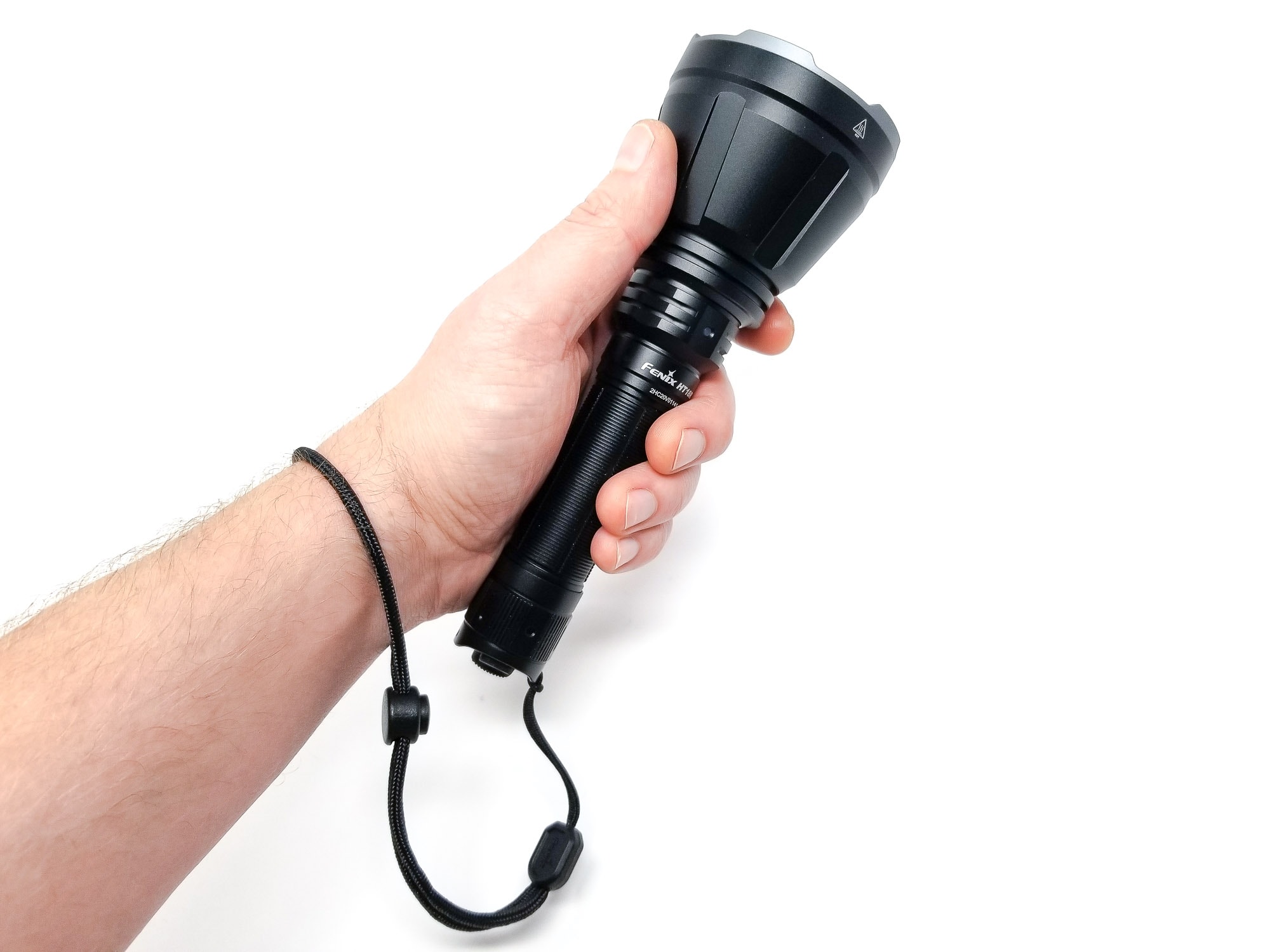
LED, Lens, Bezel, Beam, and Reflector
Fenix is happy to disclose the HT18R’s LED. The first HT18 had a Luminus SFT-40-W LED, which is an awesome all-around LED, but the R needed some more rrrrrrr’s, and so they opted for the bigger, quad-die Luminus product, the SFT70. This is Luminus’s new-ish high output, high intensity LED designed on the same 5050 substrate as the SST40, SFT-40-W and the Cree XHP50 LEDs. Unlike the latters, this is a 6 or 12 forward voltage emitter, so it needs a boost driver for 1S or a buck driver for 2 or 3S applications.
Most of the SFT70s in circulation (for flashlights anyway) are the 6 volt variety. The LES is slightly smaller than Cree’s XHP50.3 HI, so you’re getting more throw out of it without much output deficit. It’s available in CW only (for now?) and you can bet it shifts green at low output, but bright white at higher outputs. The reflector is a deep SMO (smooth) unit and it’s topped by a bead-blasted stainless bezel with big crenulations, so the AR-coated mineral glass lens is well protected. The beam is all thrower with bright spill and a focused hotspot, but it has a larger hotspot than an SFT-40 light, which makes it more useful for close-in work. It’s a pretty clean beam also with minimal aberrations. Overall, a very nice beam for a ‘working’ flashlight.
Spectral measurements:
I used the Opple Lightmaster Pro to measure the flashlight at 1 meter from the sensor. Typical of the SFT70, the tint is cool white and the duv shifts positive (=green). Not surprising, but it does turn bright white at higher output.
| Mode: | CCT: | CRI Ra: | duv |
|---|---|---|---|
| High | 6007 | 65.7 | 0.0098 |
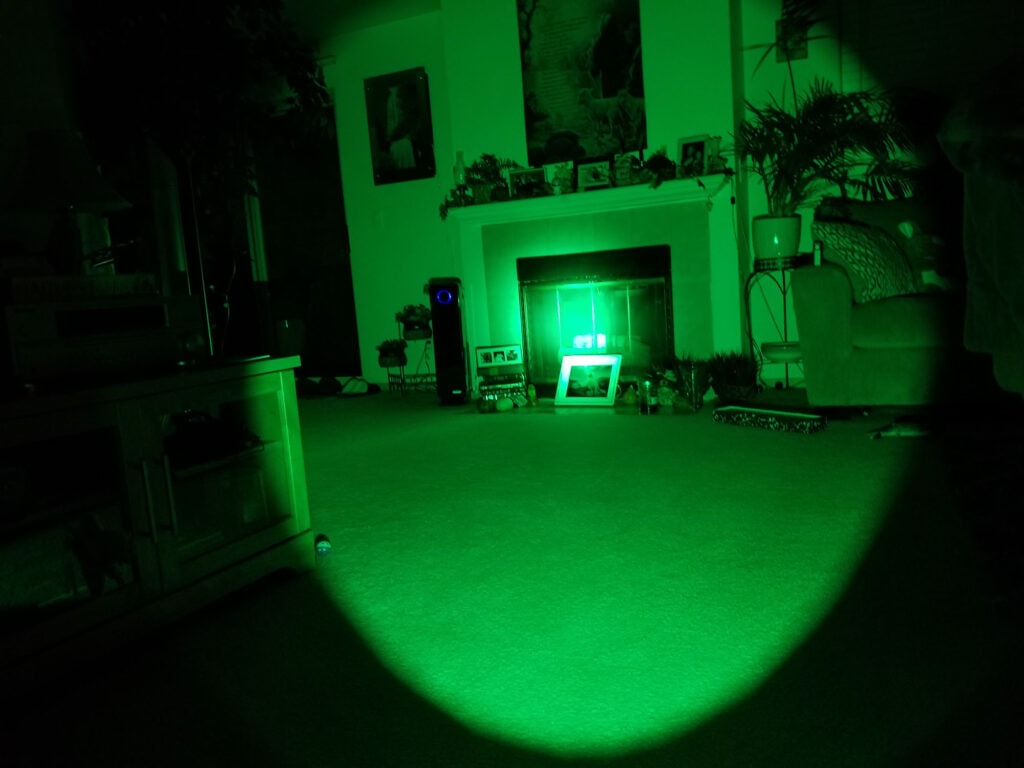
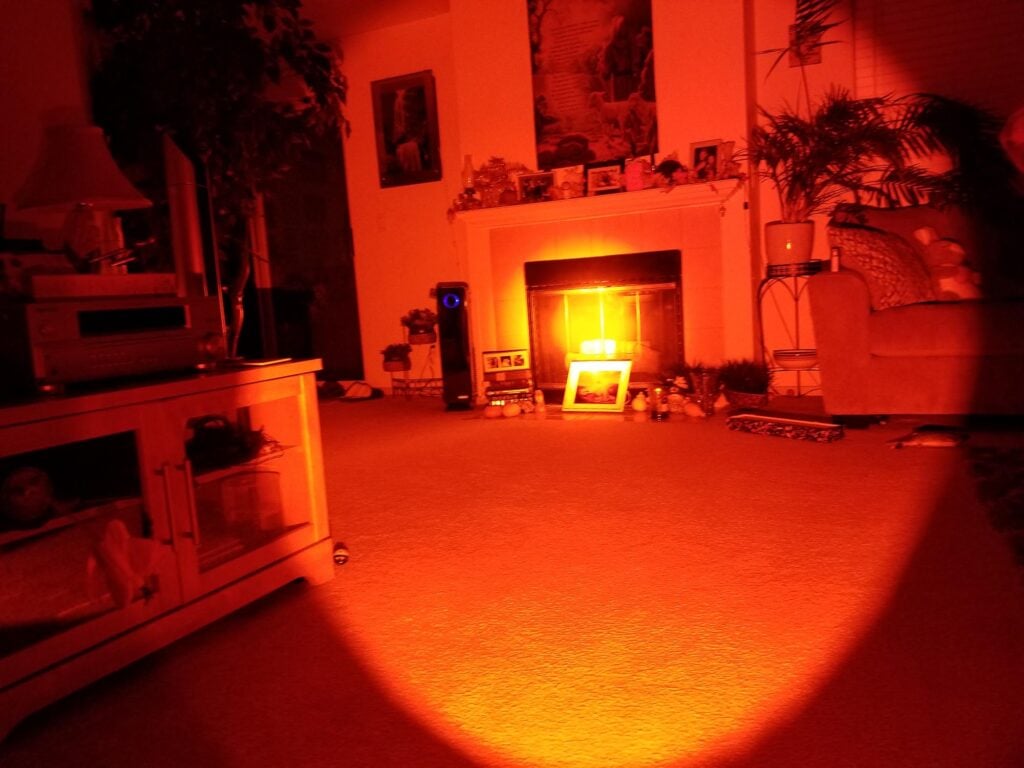
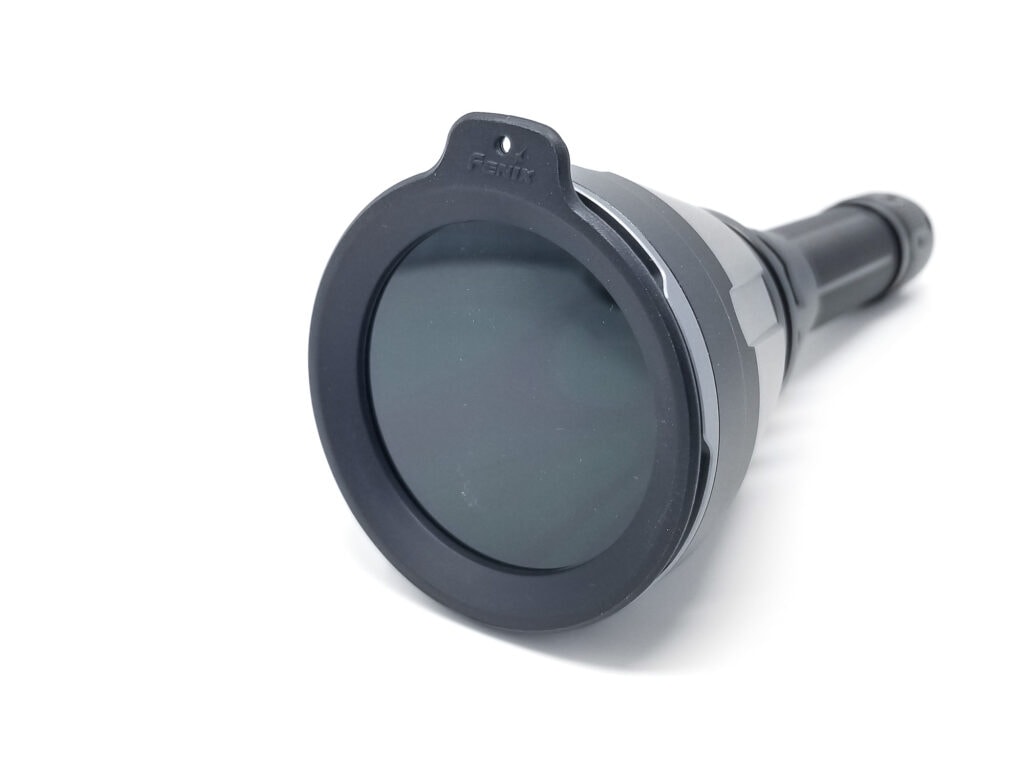
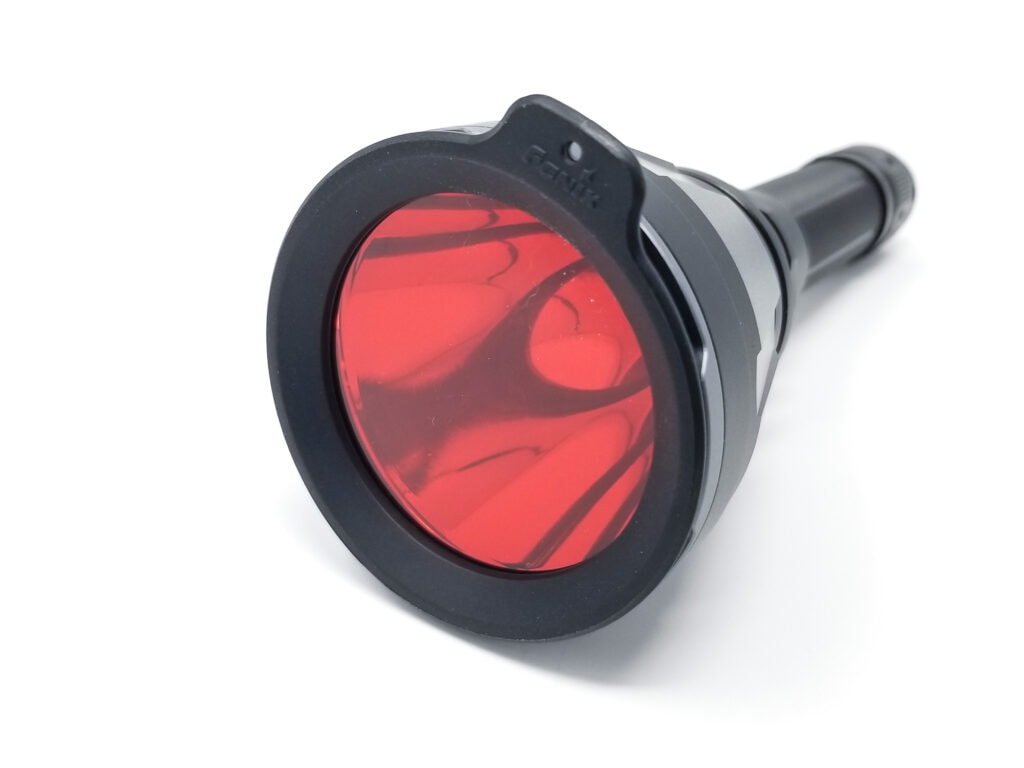
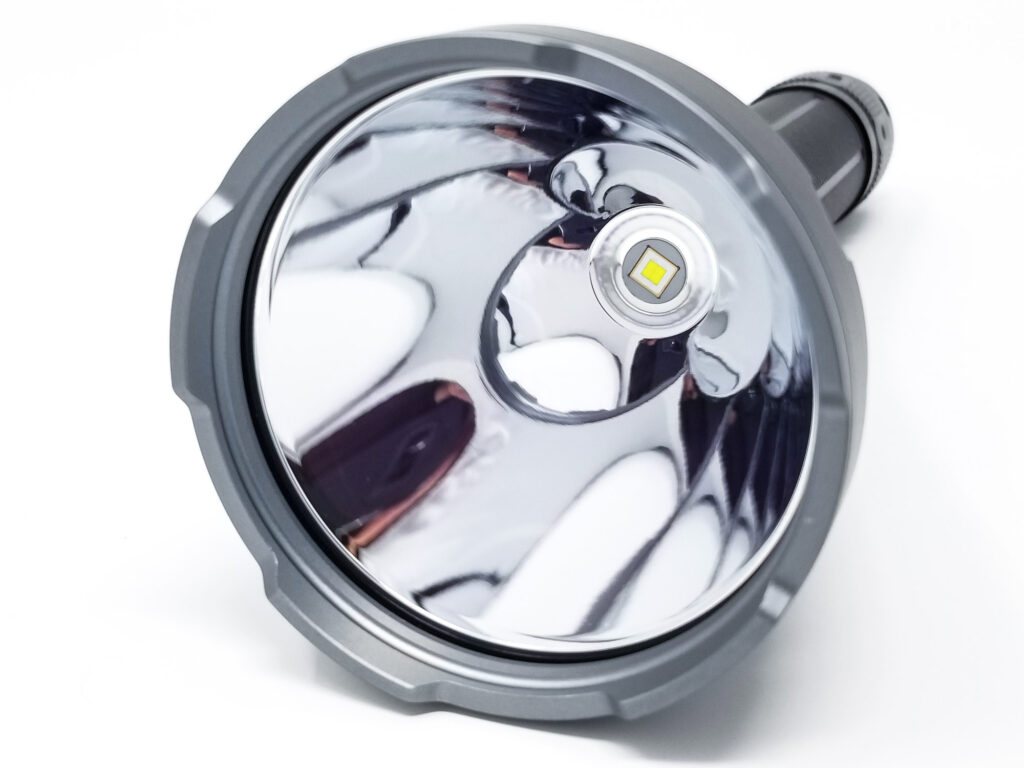
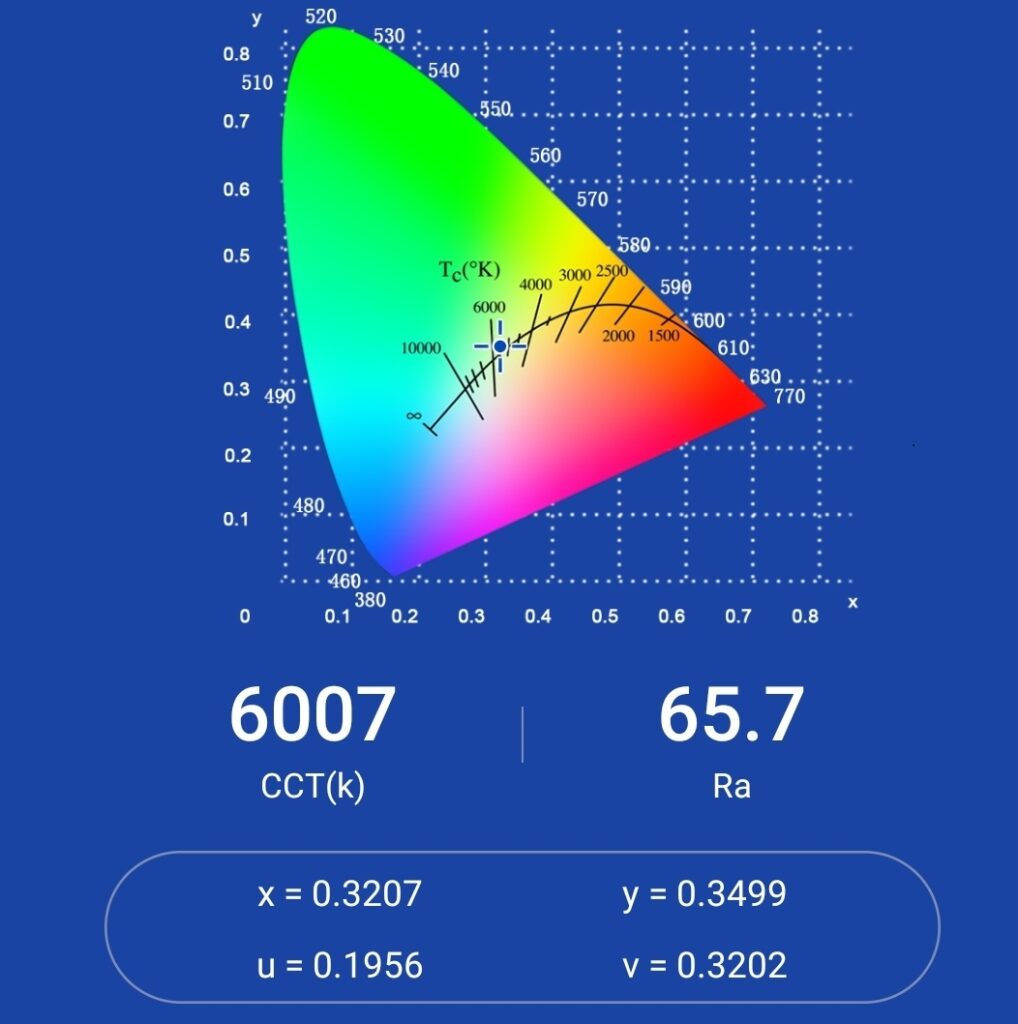
Dimensions and its competition
Dimensions:
| Fenix HT18R | Millimeters | Inches |
|---|---|---|
| Length | 188 mm | 7.4 in |
| Head diameter | 68 mm | 2.7 in |
| Body diameter | 25 mm | 1 in |
Dimensions are rounded to the nearest millimeter, and to the nearest tenth of an Inch.
Weight:
| Fenix HT18R | Weight in grams | Weight in oz |
|---|---|---|
| Without battery: | 253 g | 8.9 oz |
| With battery | 326 g | 11.5 oz |
Weight is rounded to the nearest gram, and to the nearest tenth of an Oz.
Flashlight size comparison with its competition:
Compared to some of the best long-range flashlights
Group 1 left to right: Acebeam L19 v2, Fenix HT18R, Wurkkos TS30S Pro, NatFire SF2, Thorfire C8
Group 2 left to right: Thrunite Catapult Pro, Fenix HT18R, Convoy L21B, Speras T3R
Group 3 reflectors left to right: Thrunite Catapult Pro, Fenix HT18R, Speras T3R
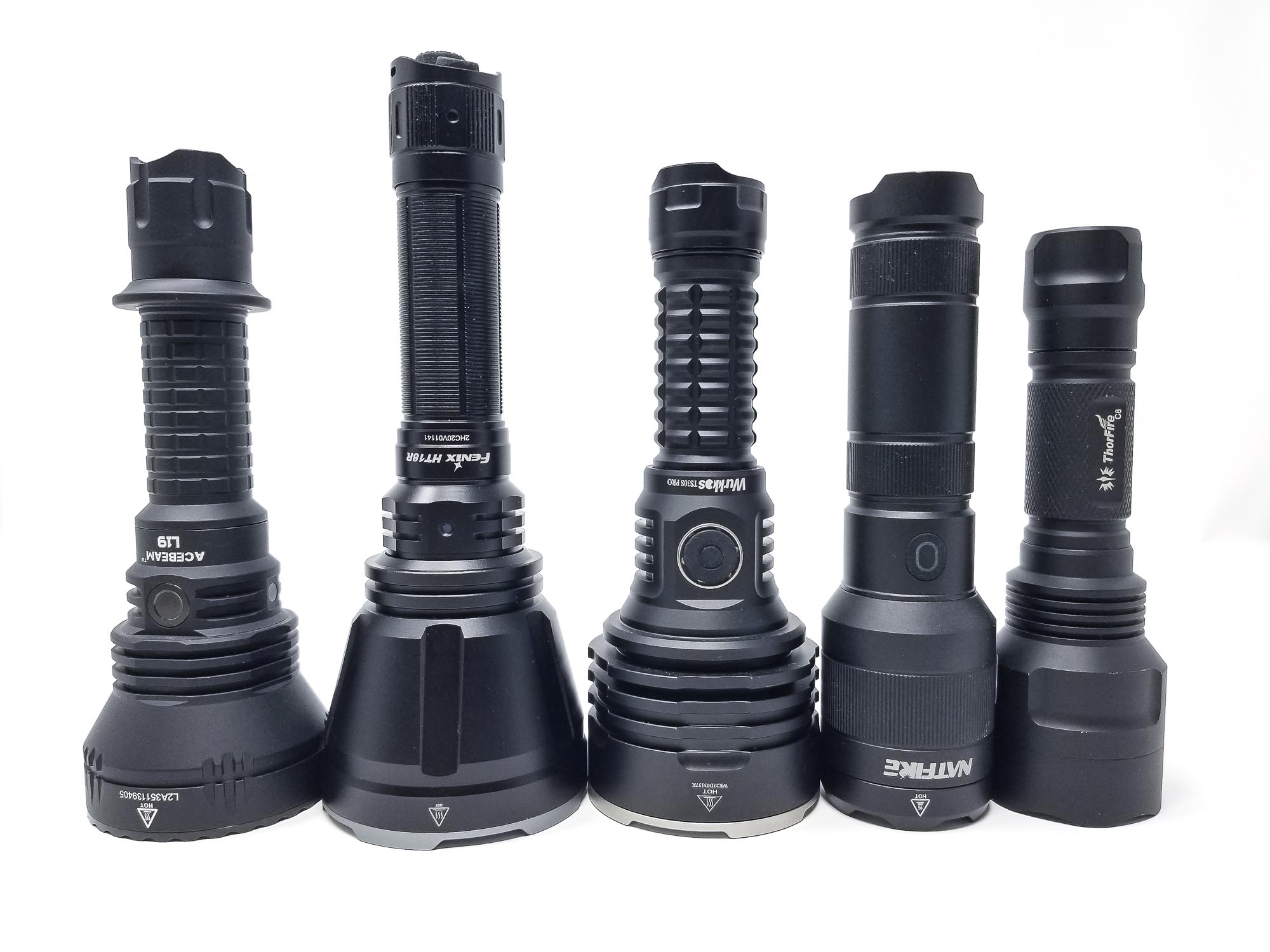
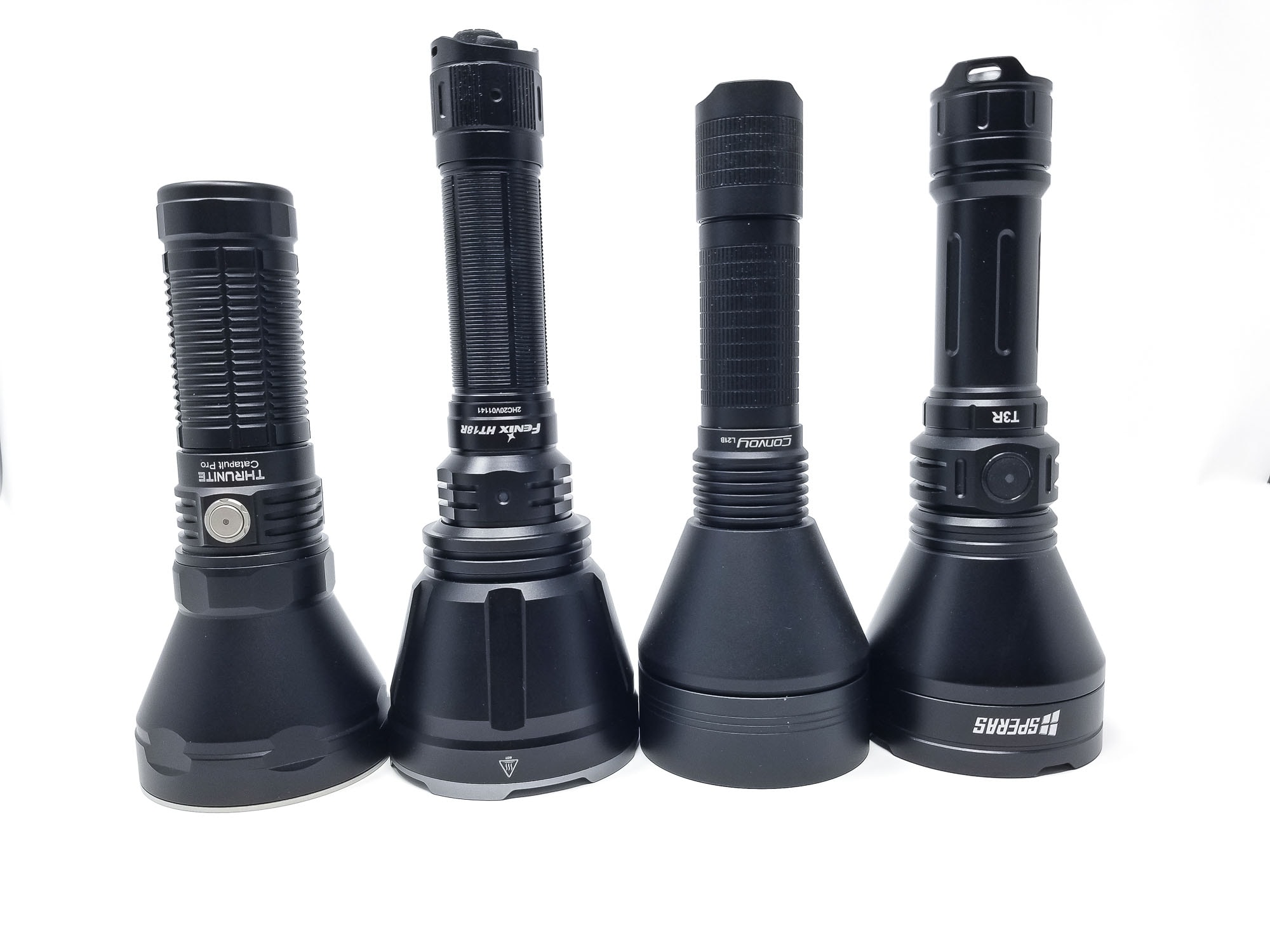
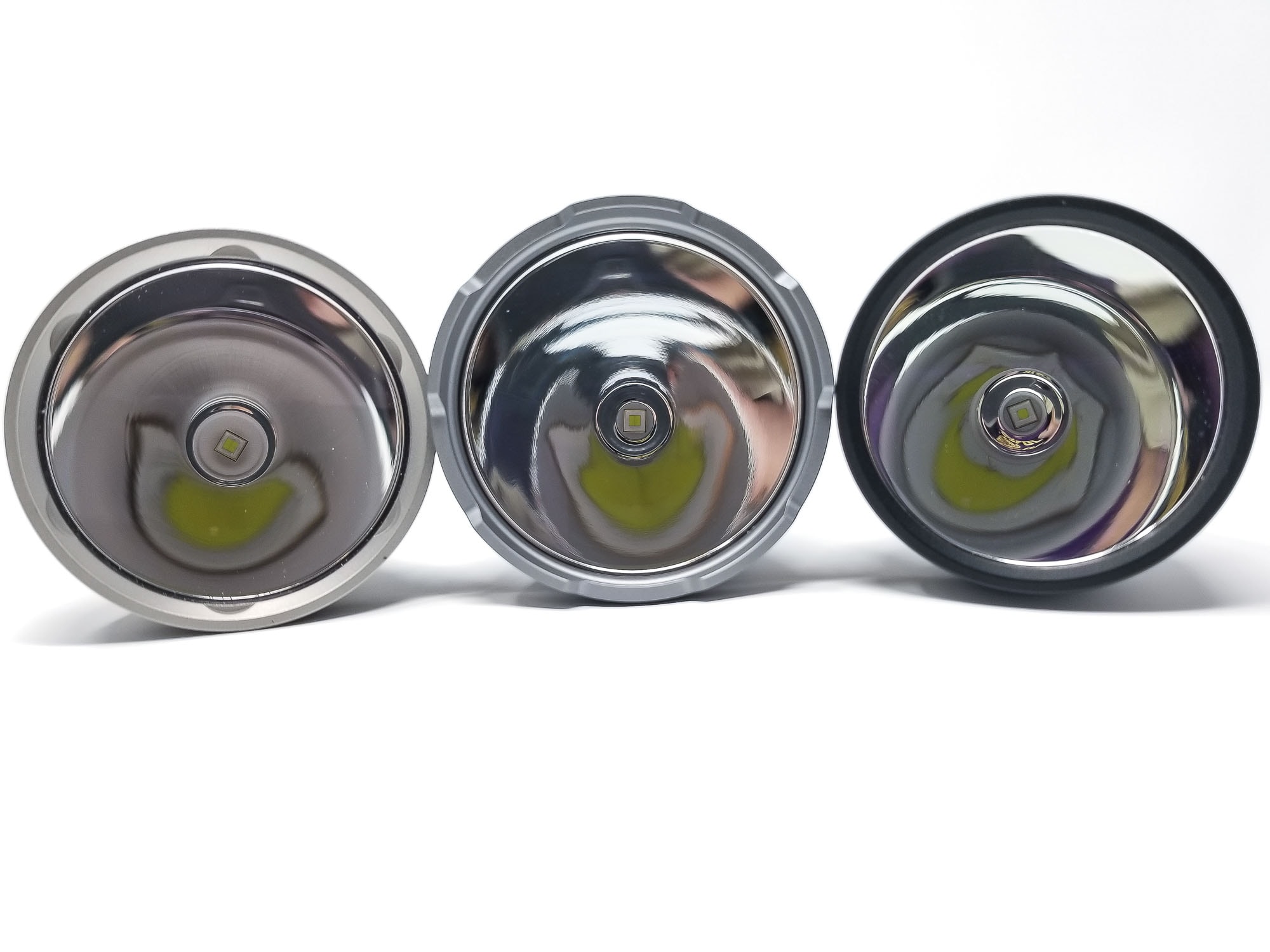
Fenix HT18R UI: User Interface and Driver
The driver is not mentioned, but since we’re driving a 6 volt LED with a single li-ion, it’s going to be a boost driver. Boost drivers are awesome and Fenix makes pretty decent ones. They’re constant current and the output doesn’t decrease as the battery drains like a FET driver. As long as the battery supplies voltage needed to keep the boost IC running, the output is laminar and regulated.
The UI is similar to the TK and PD-series flashlights. It’s super simple and very intuitive to use, which is important in a light like this. It’s 4 regular modes including Turbo plus two blinkies, Strobe and S.O.S. The mechanical clicky (called the Tactical switch) turns the light on/off, and the small e-switch (the Functional switch) changes modes or activates Strobe mode (form off).
Available modes:
- Low, Medium, High, Turbo
Available blinky modes:
- Strobe, S.O.S.
From OFF:
- Tap Tactical switch: Momentary on in the last memorized mode
- Fully click Tactical switch: Constant on in the last memorized mode
- Press and hold Functional switch: Strobe
From ON:
- Click the Tactical switch: Turns off
- Tap the Functional switch: Changes modes L-M-H-T-L
- Press and hold the Functional switch: Strobe. Release and click again to access S.O.S.
Mode memory:
- Yes, remember the last used mode including Turbo. Strobe and S.O.S. are not memorized
Shortcuts:
- None
Low voltage warning/protection:
- Yes, the light drops to a low output when low voltage is detected and the indicator LED will blink red (NOTE: This only works with the Fenix ARB-L21-5000 V2 battery). The indicator LED will show battery state for 3 seconds when the light is turned on:
- Solid green: Saturated100% to 85%
- Flashing green: Sufficient 85% to 50%
- Solid red: Poor 50% to 25%
- Flashing red: Critical 25% to 1%
Strobe/blinkies
- Strobe, S.O.S.
Lock-out mode:
- None. Unscrew the tailcap about ¼ turn to lock out
PWM
- None visible by eye
Additional/summary info on the UI:
- This UI is a carryover from the TK16 and TK20R V2 series tactical-use/duty lights (which add an ‘Eco’ mode), and I really enjoy Fenix’s ‘working’ UIs. They’re intuitive, easy to negotiate, and can be learned/mastered within a few minutes for even a novice user coming from single or two-mode flashlights like Streamlight, SureFire, etc. The mode spacing is good, and there’s a good selection of brightness levels as well. The Strobe and S.O.S. functions are hidden enough that you wouldn’t activate them unintentionally (since nobody likes being blinded by your own flashlight). It’s a simple UI, but fully features with all the creature comforts like LVP and ATR that’s going to be unintrusive. The only downside is if you use your own battery, some of the LVP features don’t work, but since LVP is built into the driver, it won’t drain your li-ions to a dangerously low voltage.
Fenix HT18R Charging and batteries
The HT18 series take 21700 size batteries, and there’s a lot of flexibility with that since you can use about any 21700 cell you want. Even standard flat tops like Samsung 40Ts, 30Ts, or 50S will work (albeit a teentsy bit loose), and I even shoehorned in a 77+ mm cell with USB C charging. Fenix includes their excellent ARB-L21-5000 V2 21700 in the kit. This is a 5000 mAh button top medium-current (good for about 10-15 amps) high capacity cell and it’s fully featured with a protection circuit and a ROM that works with the indicator LED for LVP notifications, so you lose that feature if you use a non-Fenix branded cell. The light has onboard USB type C charging, good for up to 10 watts (5 volts, 2 amps max). Connected to various power sources (a standard wall wart, power bank, and running off the LR60R power bank), I was getting about 5 volts and 1.6 to 2 amps. This charged the battery in about 3.5 hours from 2.8 volts.
| Charge type | Fits | No fit | Charge time |
|---|---|---|---|
| USB type C | Flat top and button top unprotected and protected, USB type C rechargeable | None I had on hand | On USB type C to C and A to C about 3.5 hours |
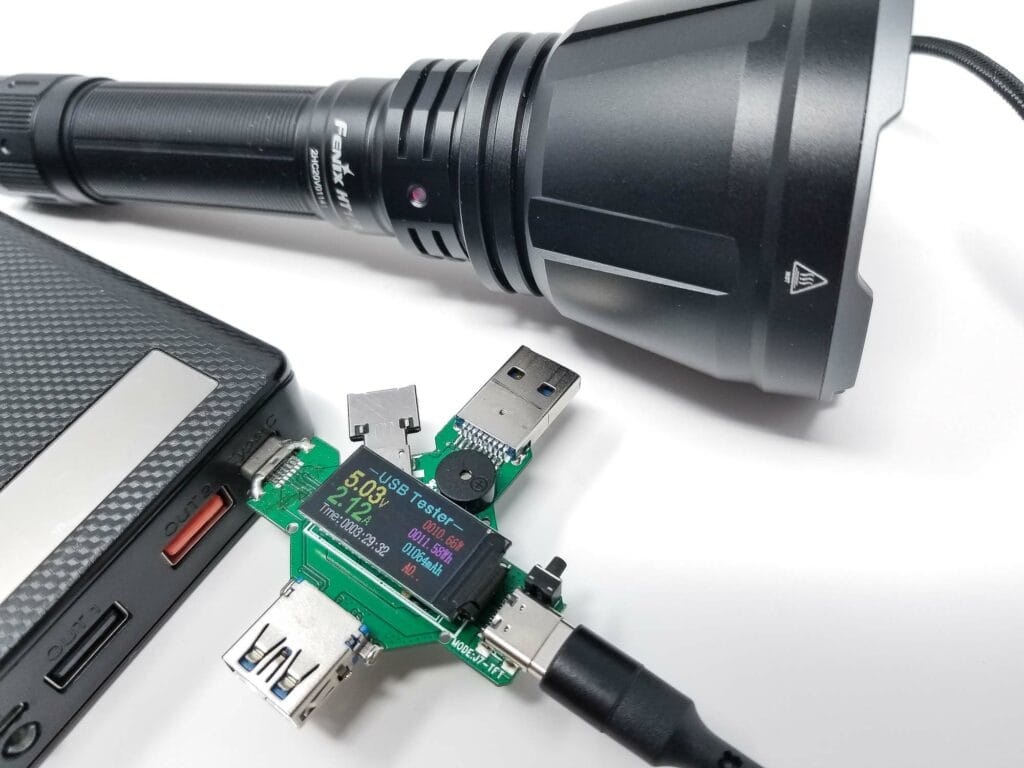
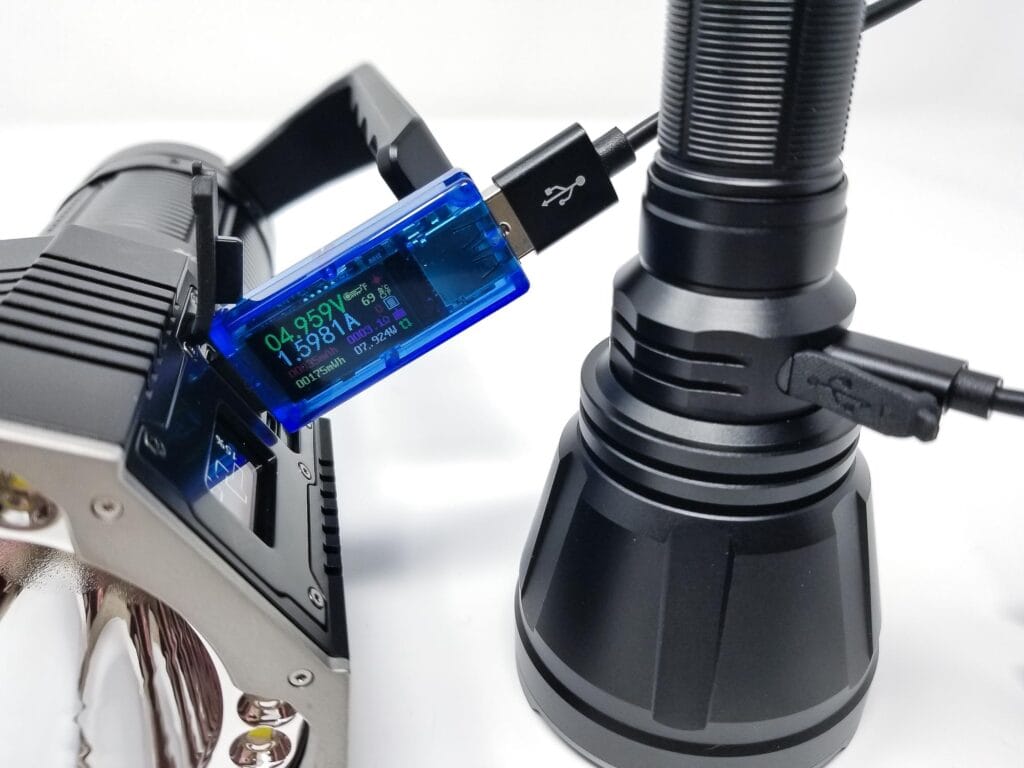
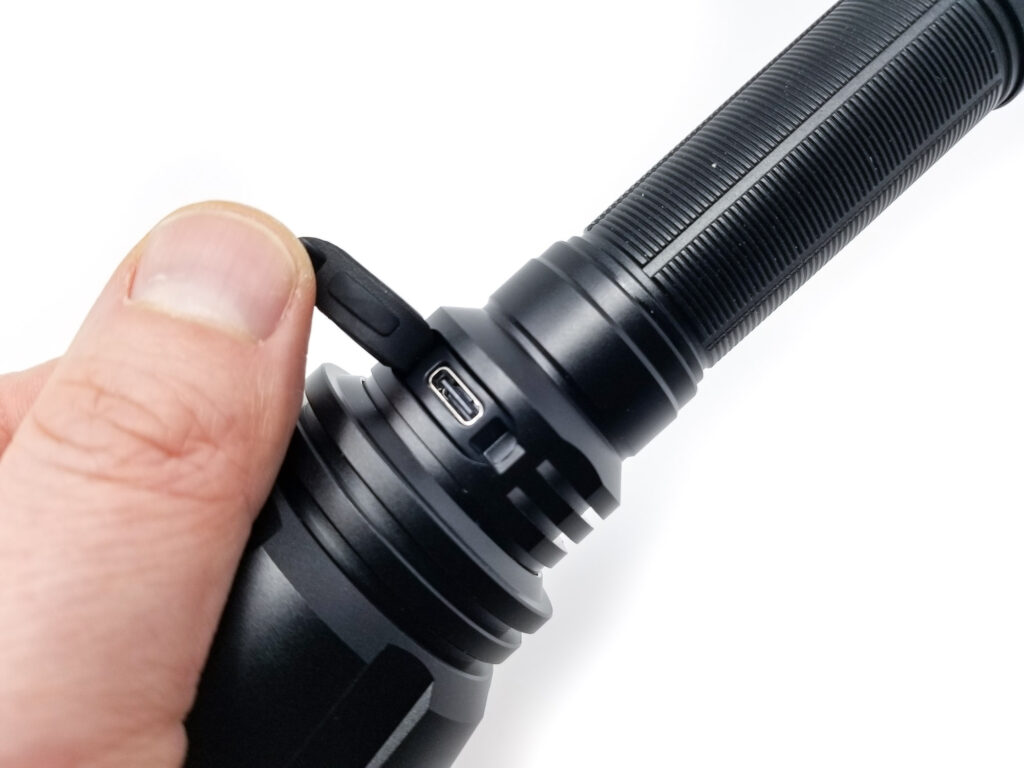
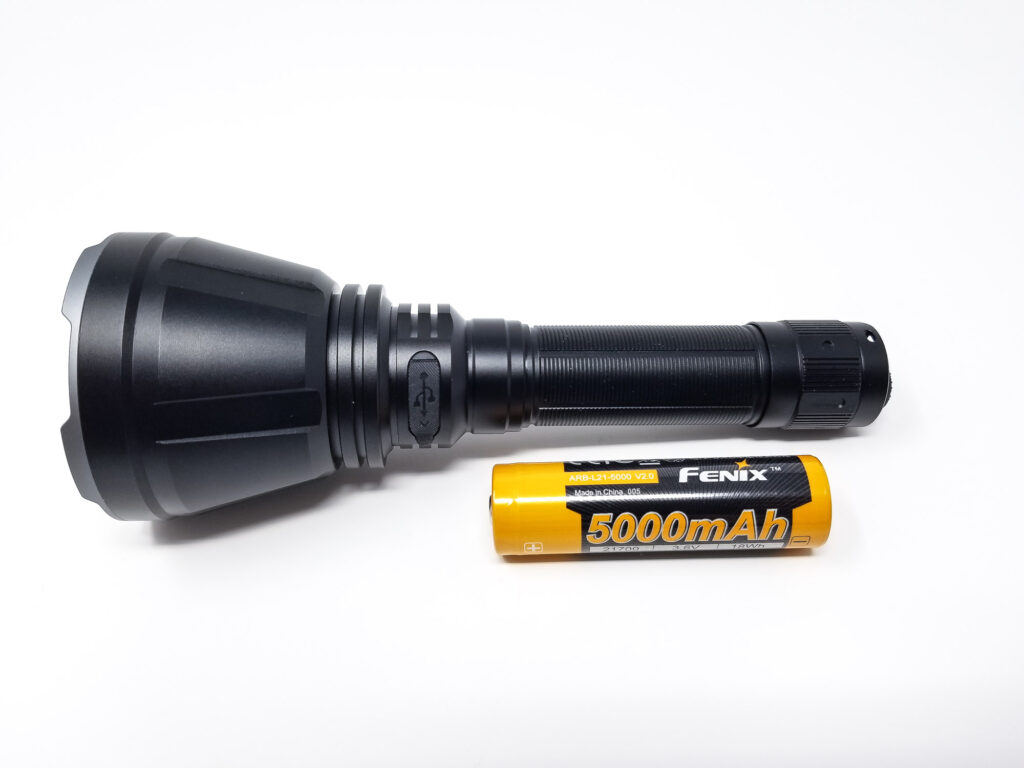
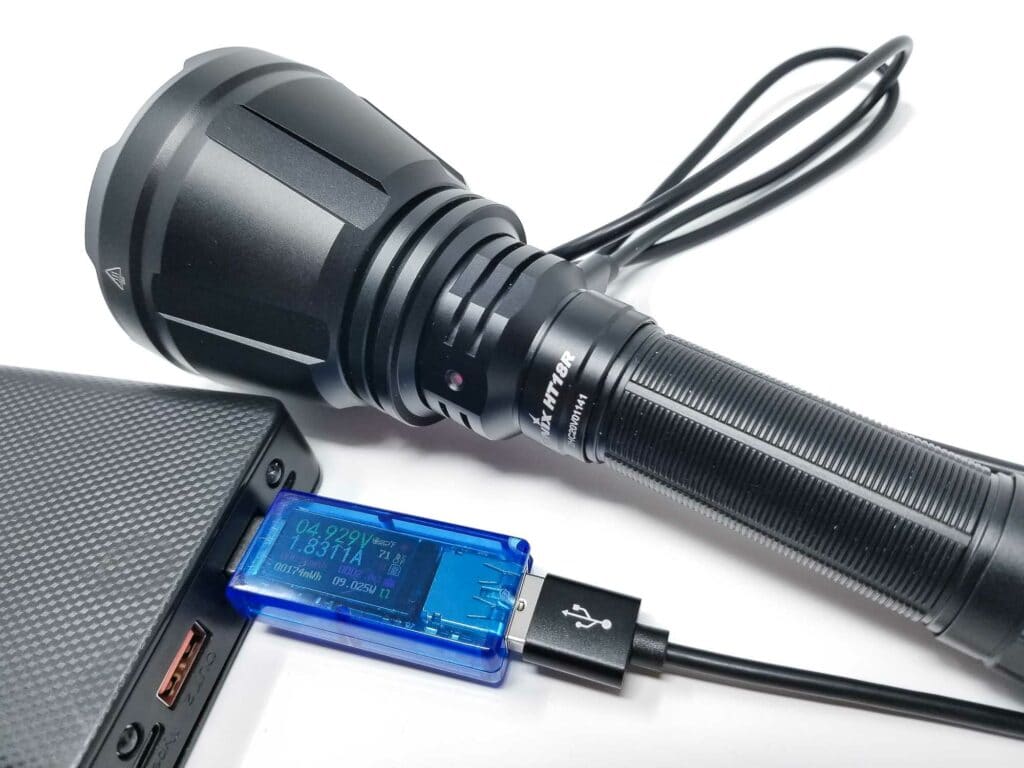
Performance test
Lumen measurements
How Lumens are Measured: Understanding ANSI FL1 Standards How Lumens are Measured: Understanding ANSI FL1 Standards: The ANSI FL1 standards specify that output in lumens should be measured 30 seconds after turning on, as this is the standardized time for measuring brightness according to the industry standard. This is why we focus on this part in our measurements. The ANSI FL1 standards require an ambient temperature of 22 ± 3°C. We record the ambient the ambient temperature to identify potential reasons for any observed discrepancies.Lumens are measured in my integrating tube made from a 4” to 3” closet elbow and two 3” street 90s with an end cap. I use a Digi-Sense 20250-00 data logging luxmeter, and the sphere has been calibrated with a Convoy S2+ measured to 260 Lumens and other lights of known output. The output figures are within 10% of actual. I tried to get current measurements with my Thinside B18B+ multimeter, but the design of the dual-switch tailcap made the measurements inconsistent, and I only got a Low mode and what I think was High mode, so I threw them out. Measurements were taken using the included fully charged ARB-L21-5000 V2 5000 mAh 21700.
| Mode | Specs | @turn on | @30 sec | @10 minutes |
|---|---|---|---|---|
| Low | 30 | 42 lm | 42 lm | – |
| Medium | 350 | 352 lm | 352 lm | 343 lm |
| High | 1000 | 1009 lm | 999 lm | 980 lm |
| Turbo | 2800 | 2529 lm | 2088 lm | 1071 lm |
Parasitic drain:
- N/A couldn’t measure
The lower modes look good, but I’m down on output for Turbo at start and ANSI.
Fenix HT18R Battery Life: Runtime graphs
How Runtimes are Measured: Understanding ANSI FL1 Standards About ANSI FL1 runtime standards: The runtime is measured until the light drops to 10% of its initial output (30 seconds after turning on). This does not mean that the flashlight is not usable anymore. The last column shows how long the light actually works till it shuts off. If there is a + symbol, it means that the test was stopped at that particular point, but the light was actually still running. This happens on certain occasions, with certain drivers, firmware, or batteries.Lumens are measured in my integrating tube made from a 4” to 3” closet elbow and two 3” street 90s with an end cap. I use a Digi-Sense 20250-00 data logging luxmeter, and the sphere has been calibrated with a Convoy S2+ measured to 260 Lumens and other lights of known output. I use a Digi-Sense 20250-92 data logging thermocouple for the temperature measurements. The probe is affixed to the head using kapton tape and uses the same 5-second sampling rate for logging. I used the included, fully charged ARB-L21-5000 V2 5000 mAh 21700 and tested all modes.
| Mode | Specified runtime | Measured runtime ANSI | Time till shut off |
|---|---|---|---|
| Medium | 6h 30m | 6h 56min | 6h 56min+ |
| High | 2h 15m | 2h 56min | 4h 09min+ |
| Turbo | 1h 40m | 1h 57min | 2h 45min+ |
The runtimes aren’t surprising here, except for a weird jump in output for Turbo mode around 1 hr 17 min into the test. I ran the Turbo test twice to validate the result and sure enough, it was replicated in both. The output is laminar after the step down for Turbo. The thermal limit seems set at around 50 C and it was always hand-friendly even on the Turbo runtime. The sustained output is about what I expect, better than 900 Lumens is pretty good, but not spectacular.
There’s no visual LVP, but the LED indicator blinks red when the battery gets low, and the output drops to a very low level that’s riddled with PWM, and it runs forever. I ended the tests after letting the light run for a while after the final step downs. I compared the HT18R to some other 1000 meter throwers, and the results are pretty similar, with roughly 1000 Lumens sustained output.
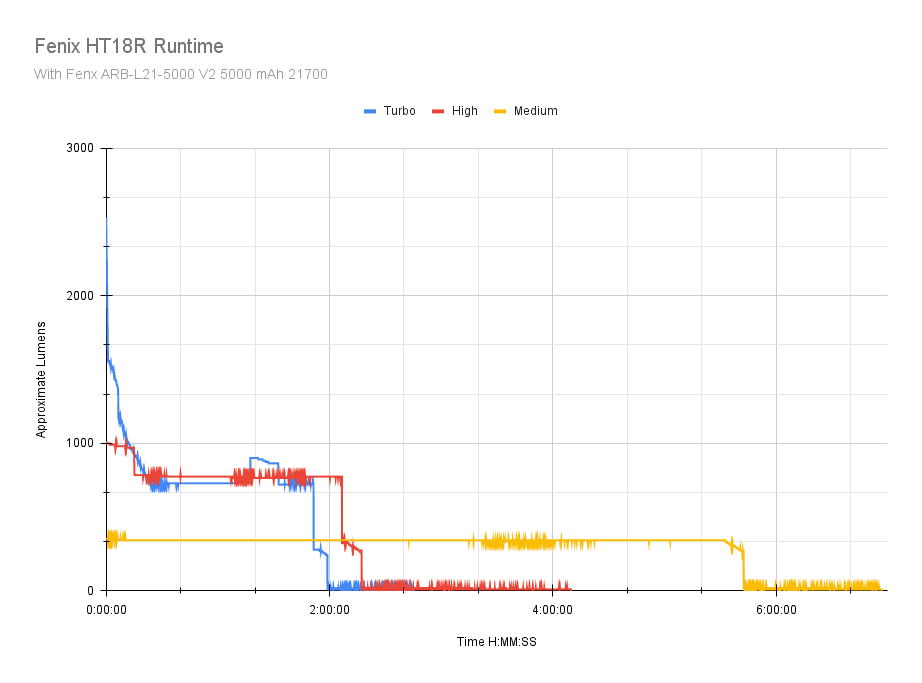
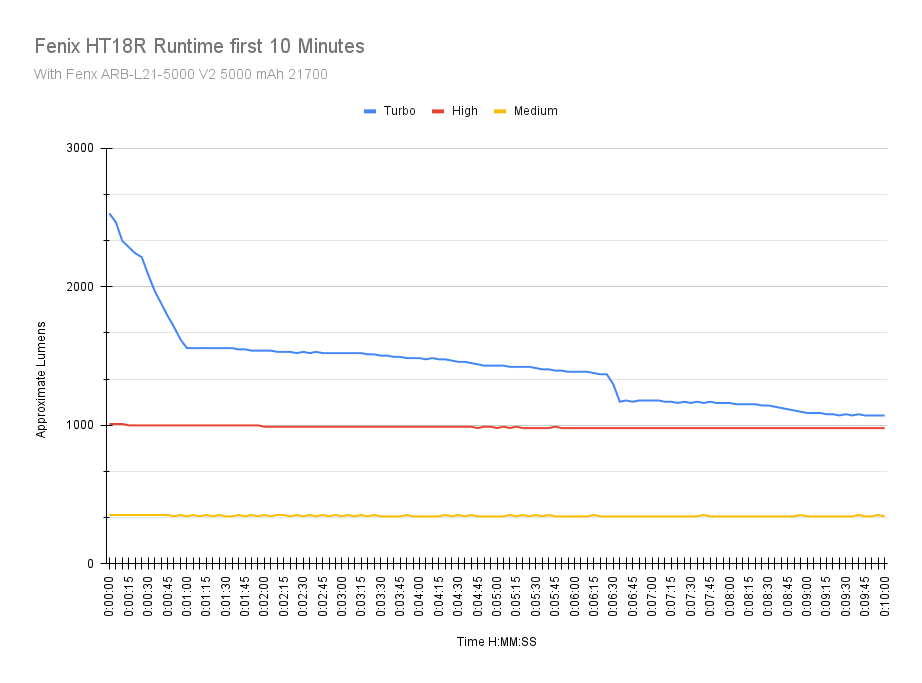
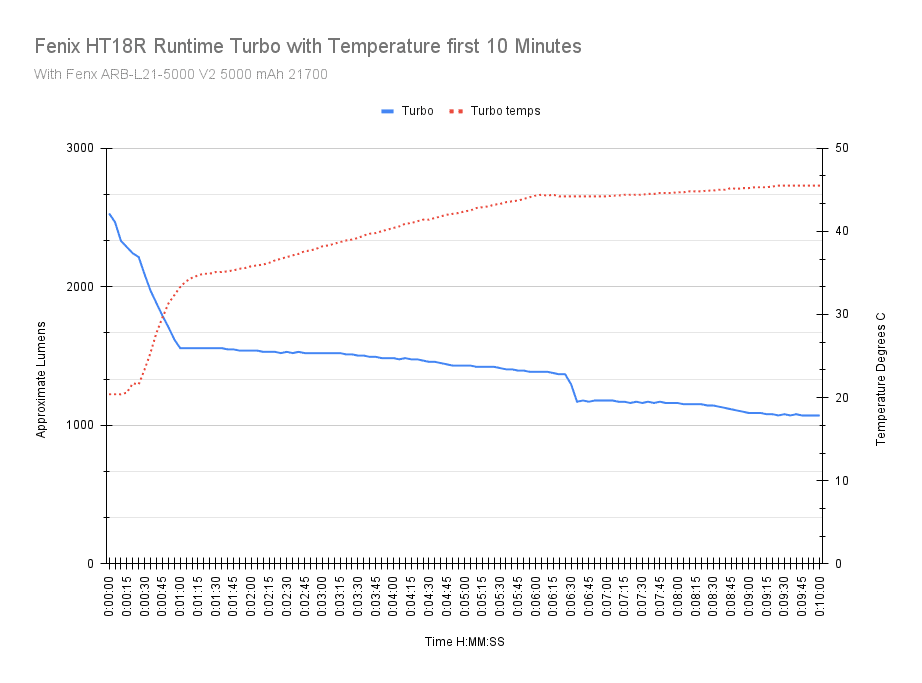
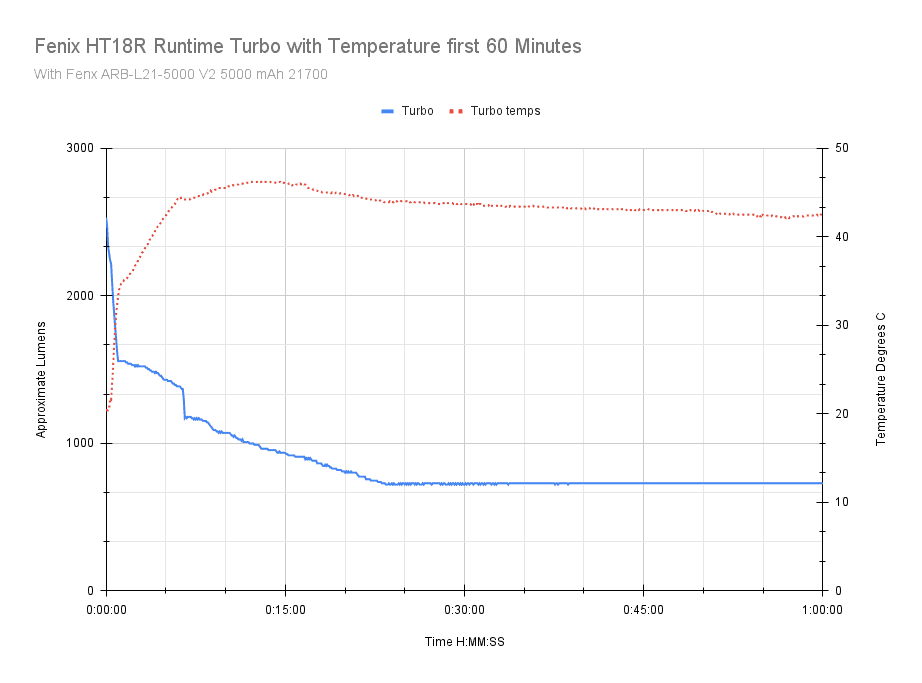
And here some comparisons with some of its competitors
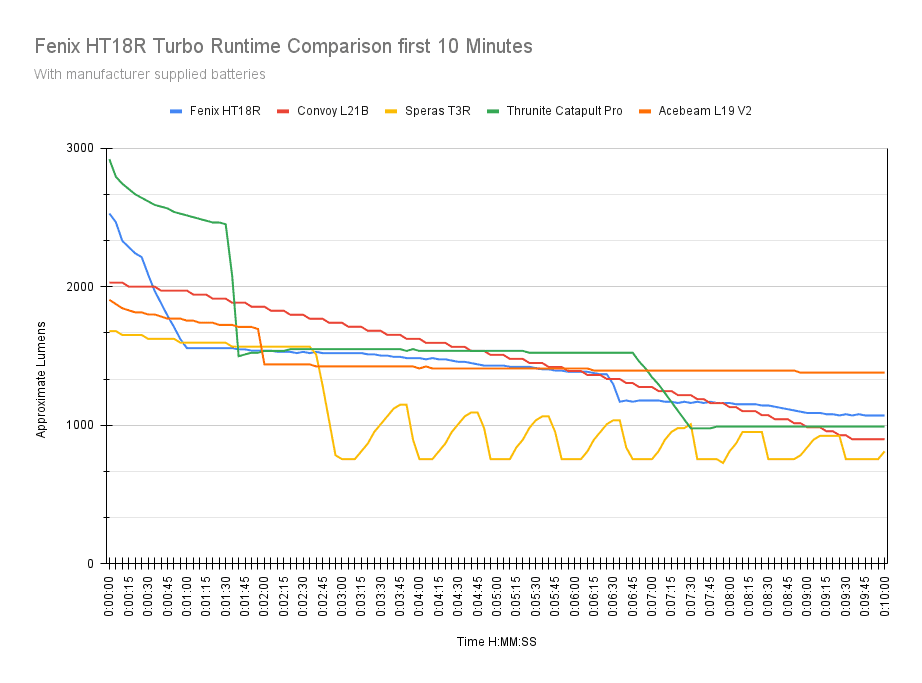
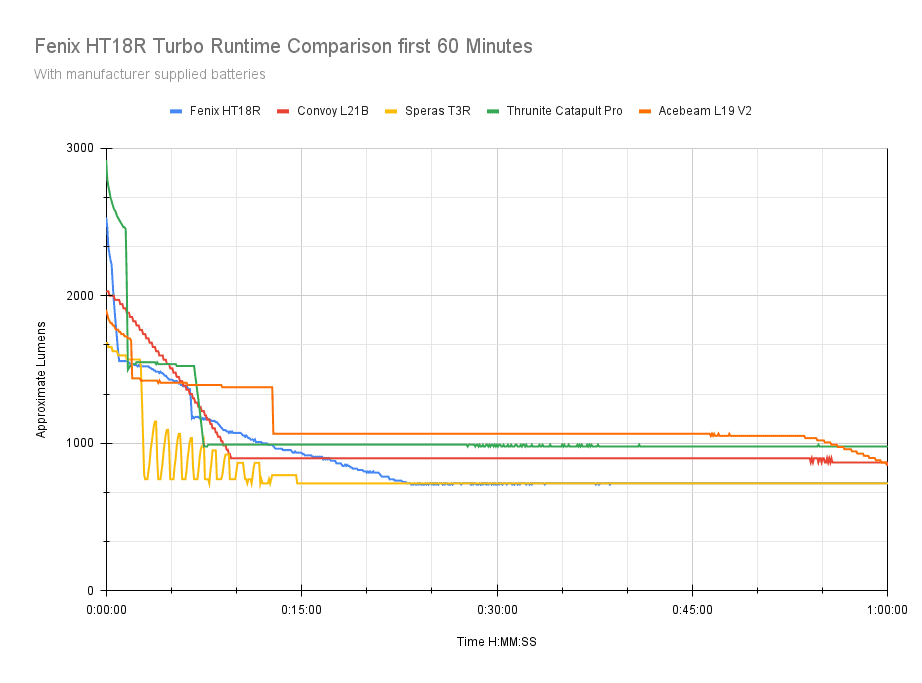
Peak beam intensity and beam distance measurements
About Peak beam intensity: Understanding ANSI FL1 Standards About peak beam intensity The calculated value of distance in meters at which the flashlight produces a light intensity of 0.25 lux. (0.25 lux is about the brightness of a full moon shining on an object). This means that the intensity has decreased so much, it becomes difficult to see darker objects, or objects that don’t reflect light. The columns ‘Meters’ and ‘Yards’ use rounded numbers.Beam distances are measured using a Uni-T UT383S luxmeter measured indoors at 5 meters using the included fully charged ARB-L21-5000 V2 5000 mAh 21700.. Measurements taken at 30 seconds.
| Mode | Specs | Candela measured | Meters | Yards |
|---|---|---|---|---|
| Low | 3000 cd | 4075 cd | 128 | 140 |
| Medium | 40,000 cd | 36,025 cd | 380 | 415 |
| High | 113,000 cd | 100,375 cd | 634 | 693 |
| Turbo | 300,000 cd | 248,725 cd | 997 | 1,090 |
| Turbo at start | ? | 276,500 cd | 1,052 | 1,150 |
I’m coming in low on the higher modes, especially Turbo. Still, it’s within my 10% of spec, and this is plenty of reach for long-range duties and beyond the range of the unaided eye in the dark.
Beamshots
Camera settings and distance: Photos taken with my Samsung Galaxy Note 8 with the camera set to ISO 400, 0.5s, and 5000K WB. The water tower is about 950 meters distant.
Beamshots of the following flashlights compared:
- Fenix HT18R
- Acebeam L19
- Acebeam L19 V2
- Thrunite Catapult Pro
- Convoy L21B
- Speras T3R
- Fenix LR60R High Search Mode
- Wurkkos TS30S Pro
Please note that beamshots are mainly intended to showcase the beam pattern and beam quality, rather than overall performance. These images are typically taken directly after activation, and do not fully represent its overall performance. For accurate performance metrics, such as output, beam distance, and runtimes, you need to look at the performance section of this review.
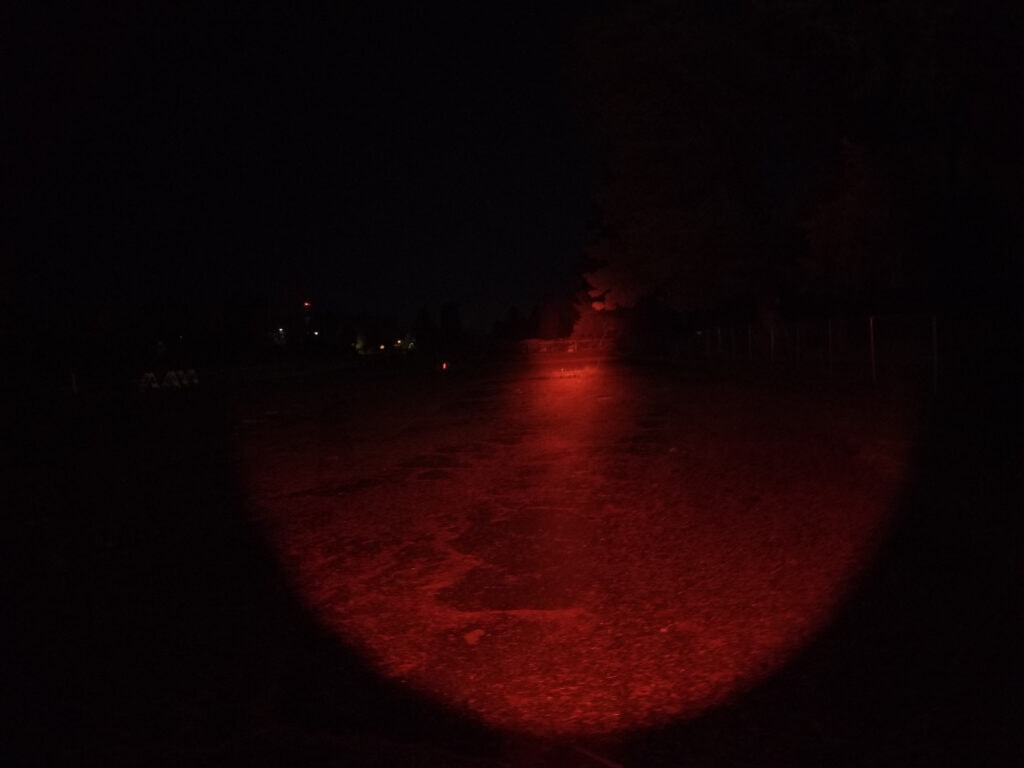
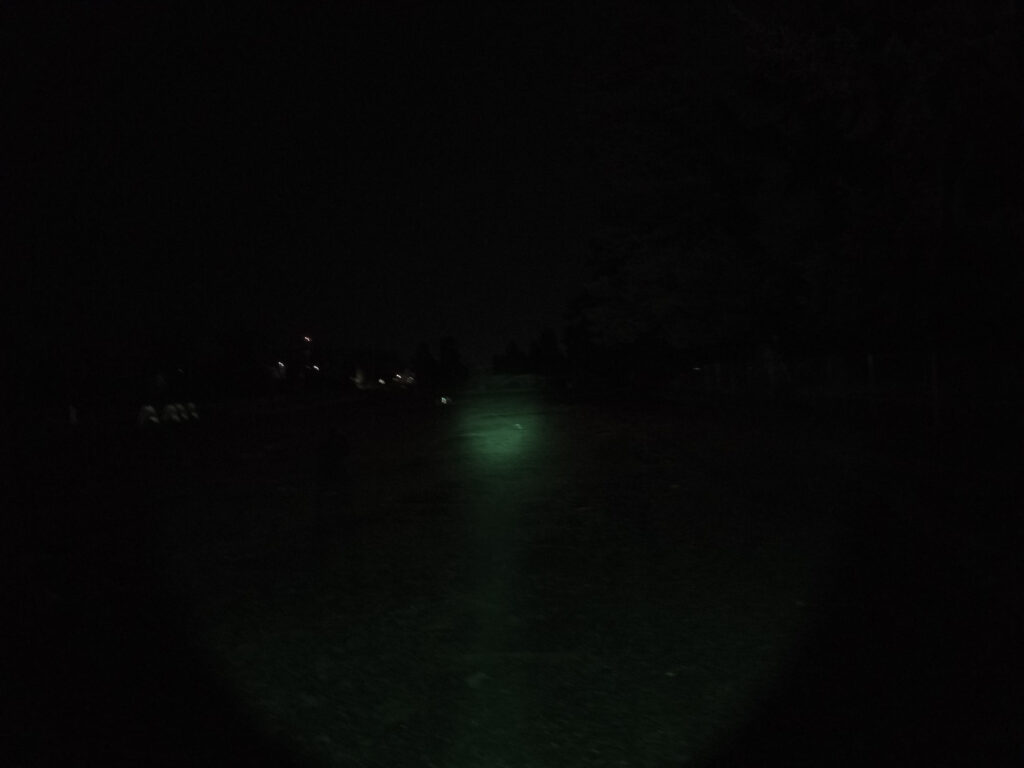
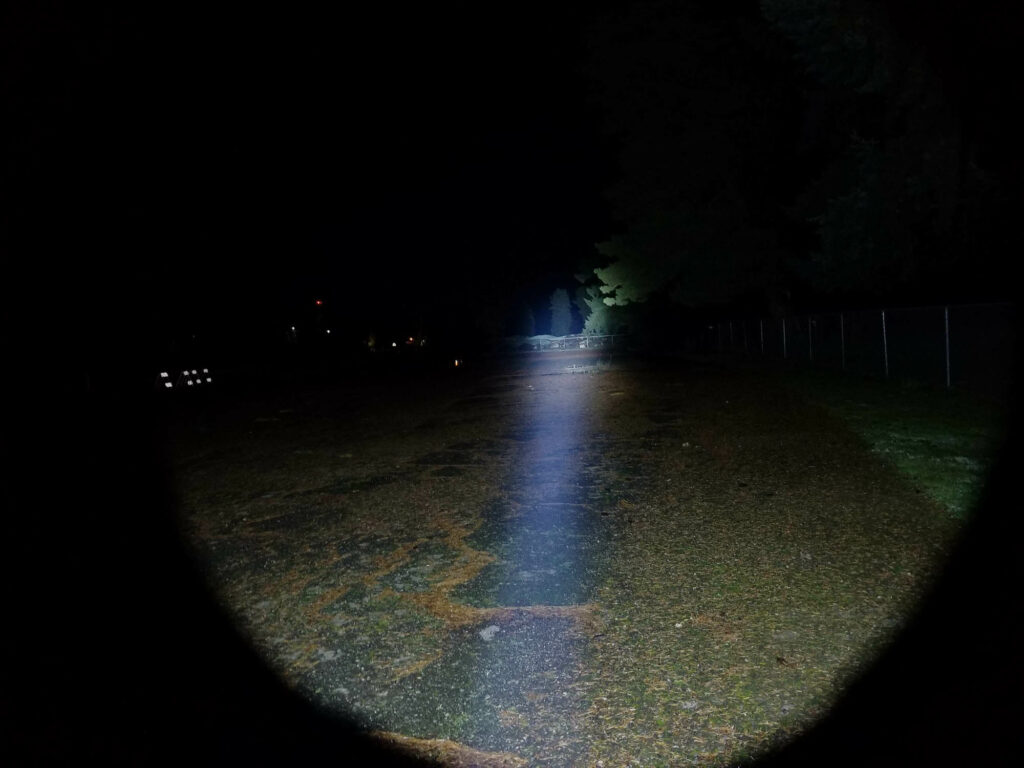
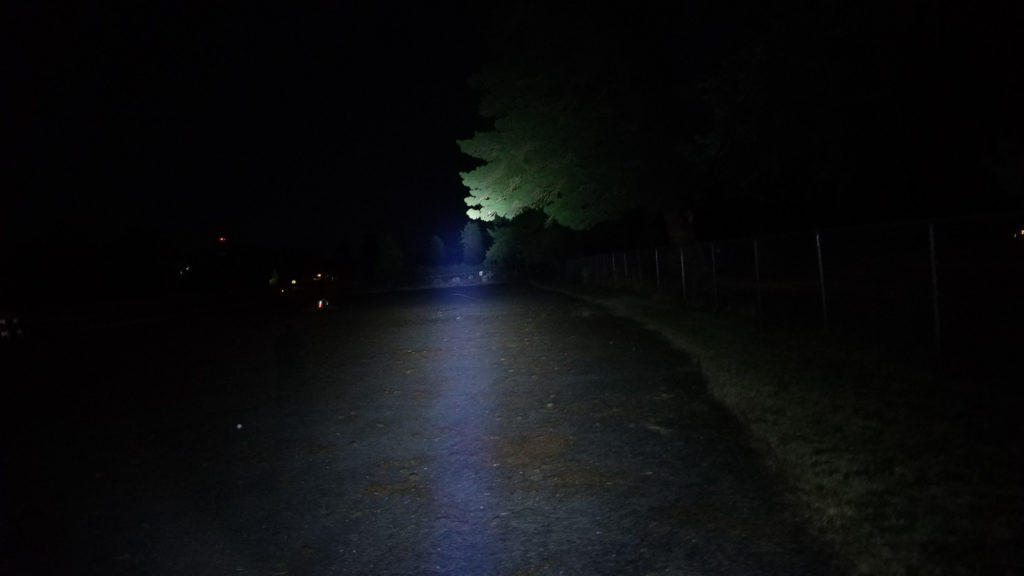
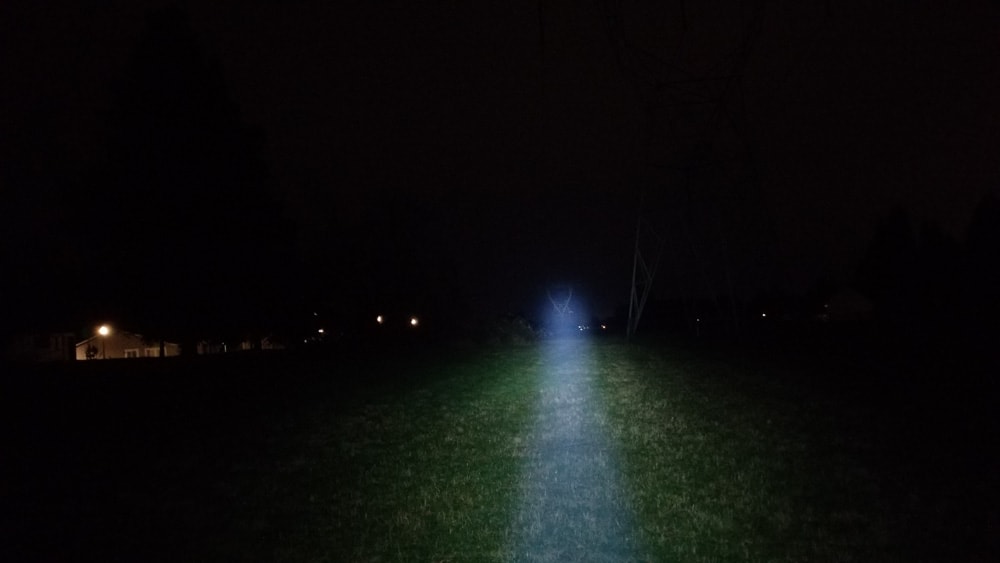
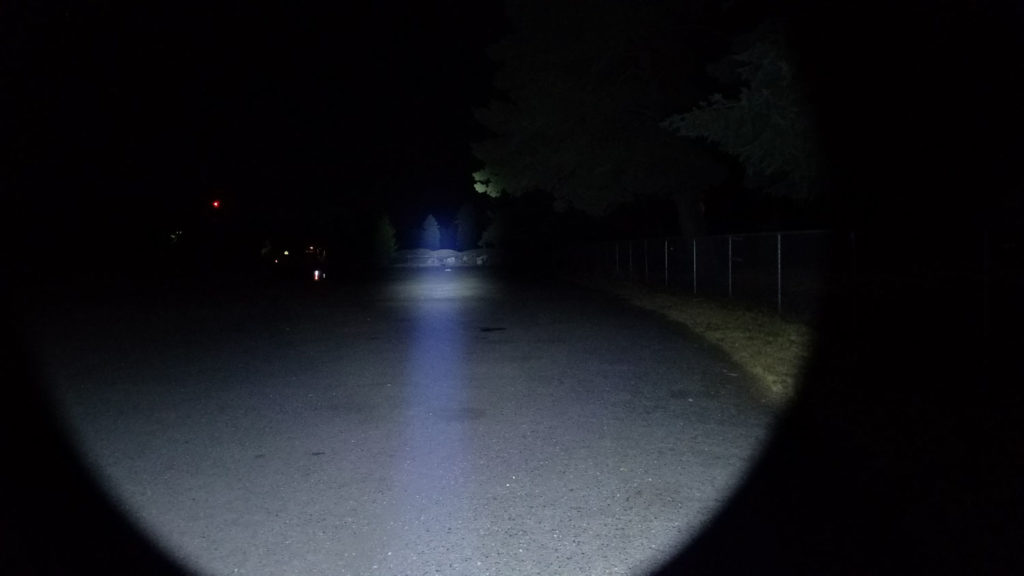
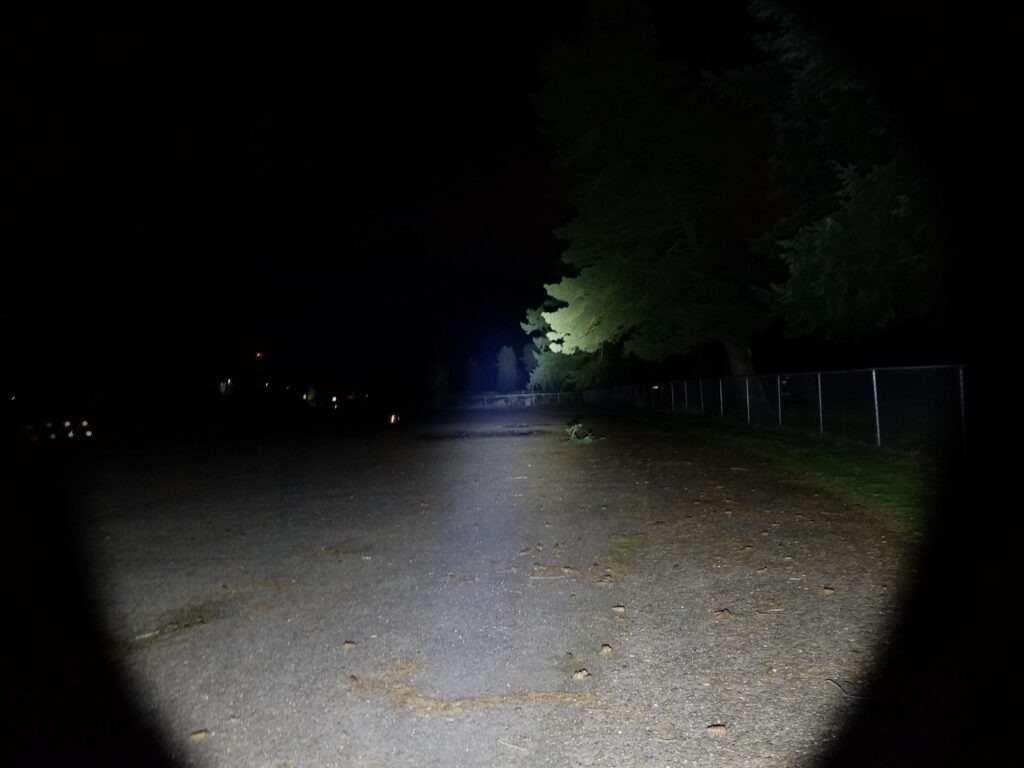
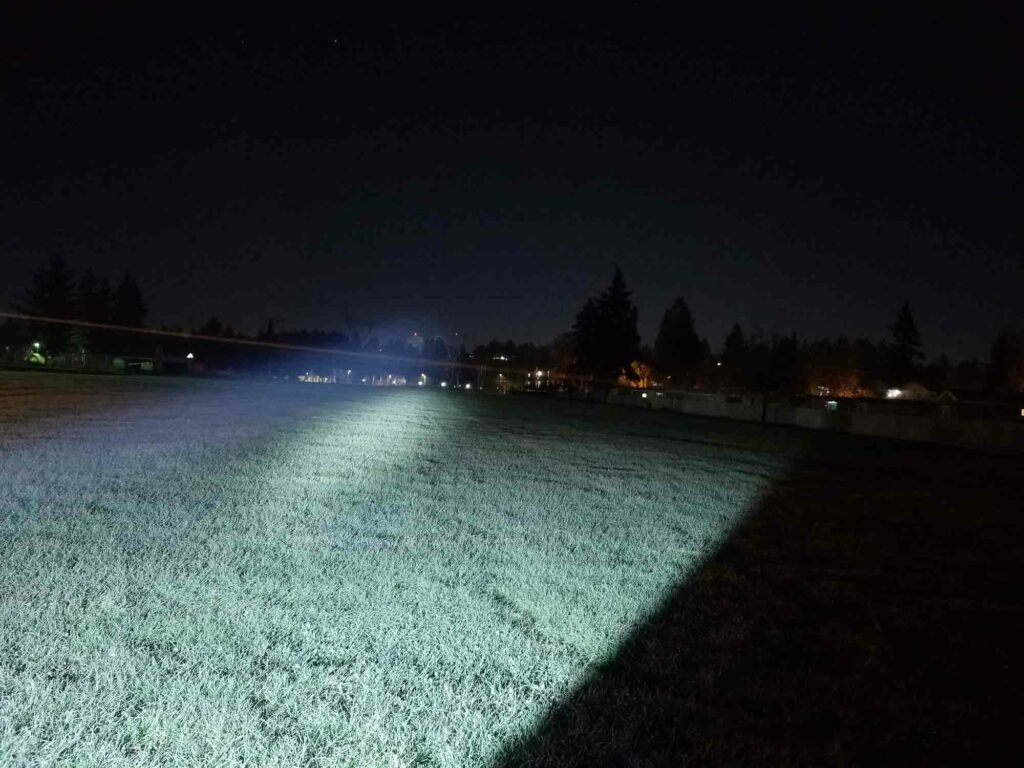



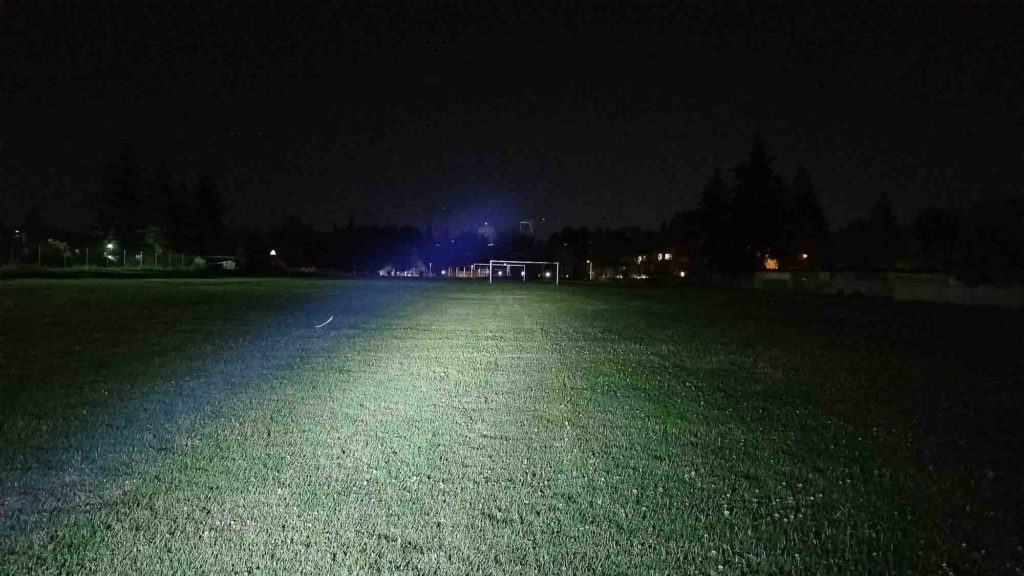
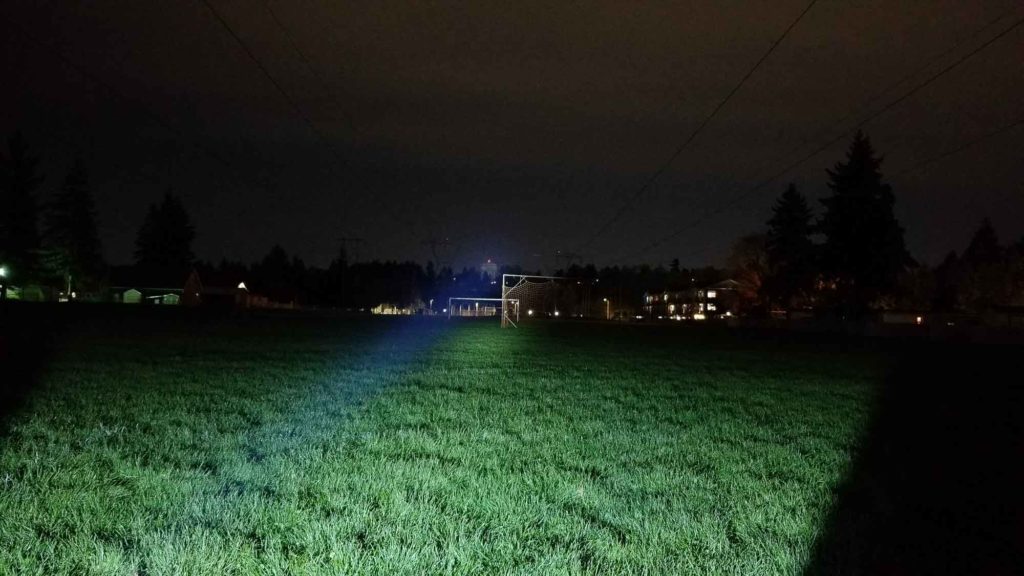


Disclaimer: This flashlight was sent to us for review at no cost by Fenix Lighting US. We have not been paid to review, nor have we been holding back on problems or defects.
Final Verdict
Pros
- Excellent build quality, fit and finish
- Fully regulated output
- Nice beam
- Uses non proprietary batteries
- Dual switch UI
- Swappable filters
- Lots of weapon mounting options available
Cons
- Down on output specs from advertised
- The Convoy L21A and L21B
Explanation on star ratings:
1: Avoid: a match would be a better choice – 2: Poor: significant defect or issues; almost unusable – 3: Average: some defects or issues; but still usable 4: Good: recommended (minor issues) – 5: Great: highly recommended

4.5 stars: ★★★★⋆
While our star rating provides a reliable indicator, we encourage you to read the full review to make an informed decision based on your own needs and preferences.
Okay so here we are again at the tail end of another Fenix review of a redesigned, updated flashlight. The HT18 was a solid long-range hunting/outdoors/general purpose light and fit the bill for a lot of use cases. However, time rolls on and new technology comes out necessitating updates to keep things current (relevant, mostly).
The HT18R is another in a long list of older lights that Fenix keeps alive through upgrades to stay competitive amongst rivals who are fielding high-performance lights at much lower prices (Convoy L21B, anyone?). I think they’ve done a good job here. The HT18R gets a nice output boost, swappable filter elements, and a plethora of long-gun mounting options (and one for a bike).
The beam is nice, with a versatile profile that’s a nice mix of general purpose and thrower. I like the dual switch setup also since it allows one-handed operation, and easy operation when mounted to a rifle without a remote switch. There’s not much to nit-pick here, but it didn’t meet the output specs, and while not a deal-breaker, it doesn’t have true instant Turbo mode (just Strobe).
It’s also a hard sell because you can get a Convoy L21B and L21A for around $40-$50…shipped…with a battery. If you’re on a budget and can live without the Fenix’s add-ons, it’s almost a no-brainer. However, that’s neither here nor there, because at the end of the day, this is a great all-around long-distance utility thrower and hunting light even at the high price of admission. 4.5 stars.
Buy your Fenix HT18R with a discount
Get 10% off every purchase at Fenix Lighting US, by using our exclusive 1lumen discount code: 1lumen10
1lumen selects and reviews products personally. We may earn affiliate commissions through our links, which help support our testing.